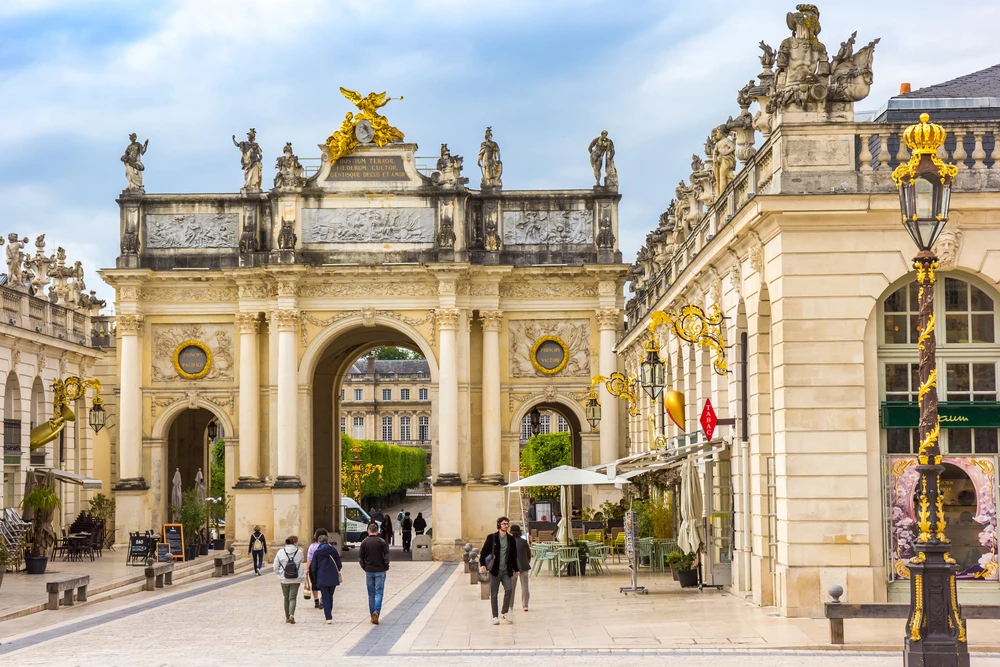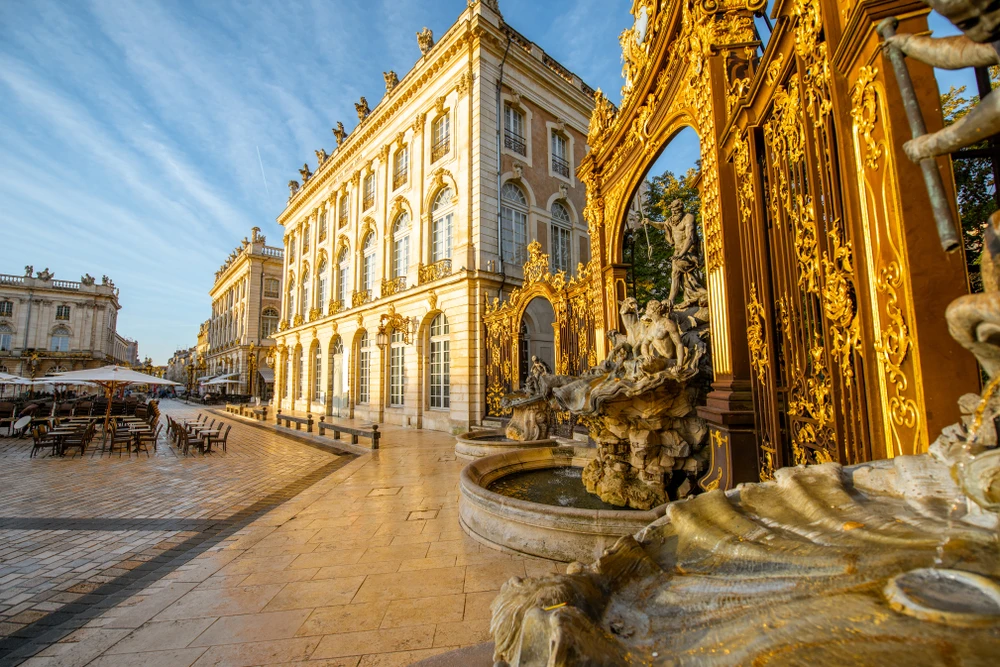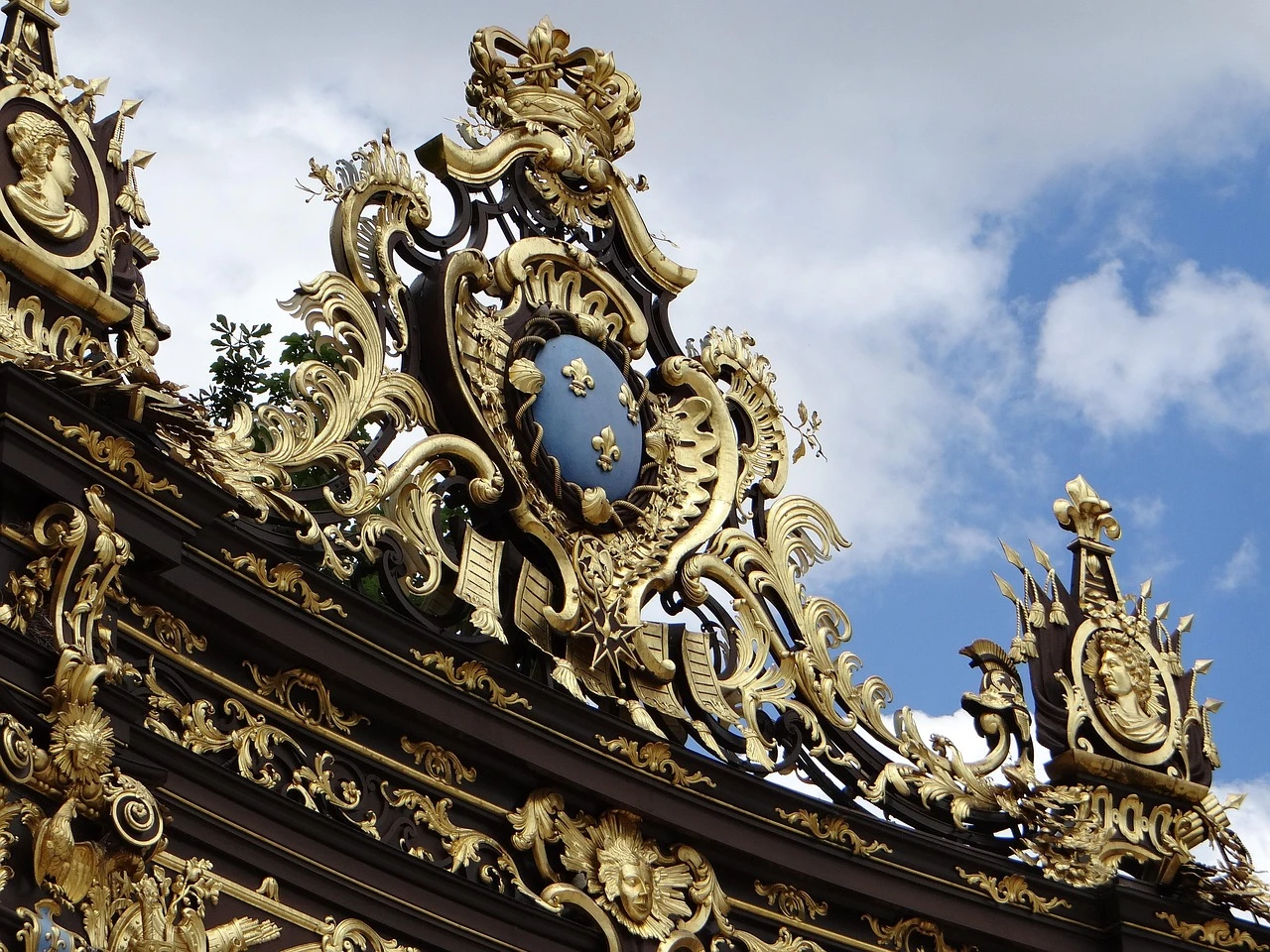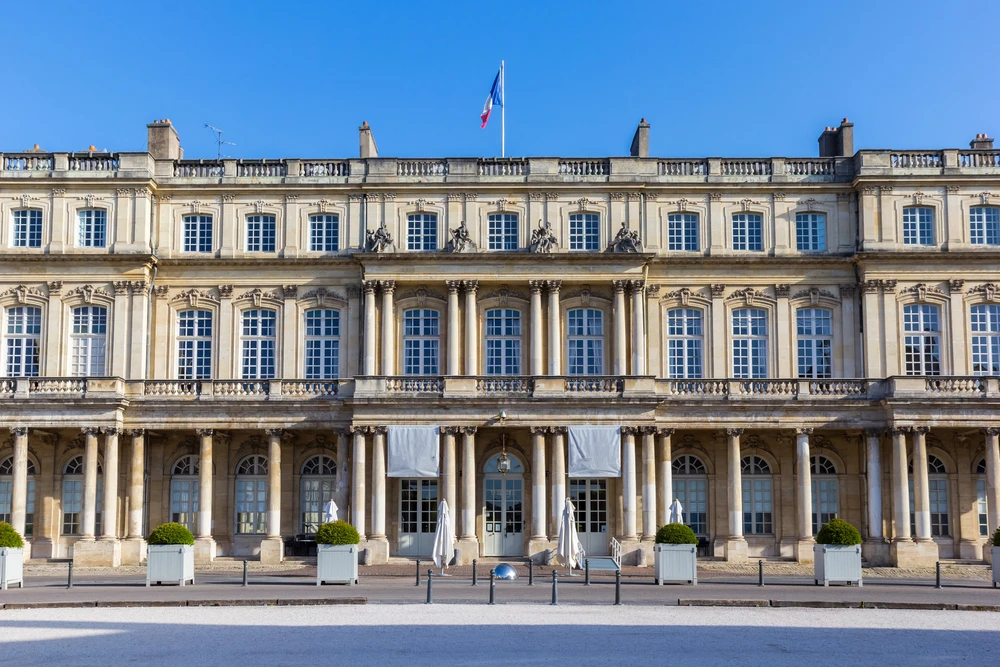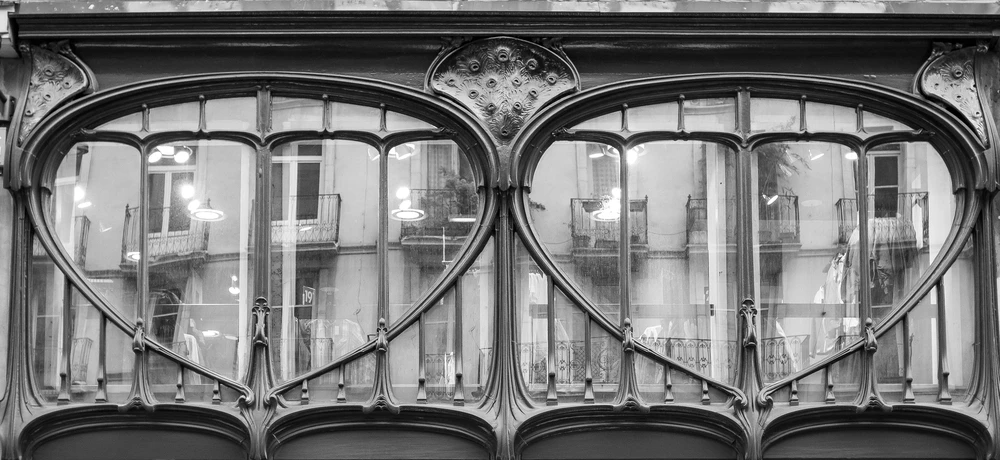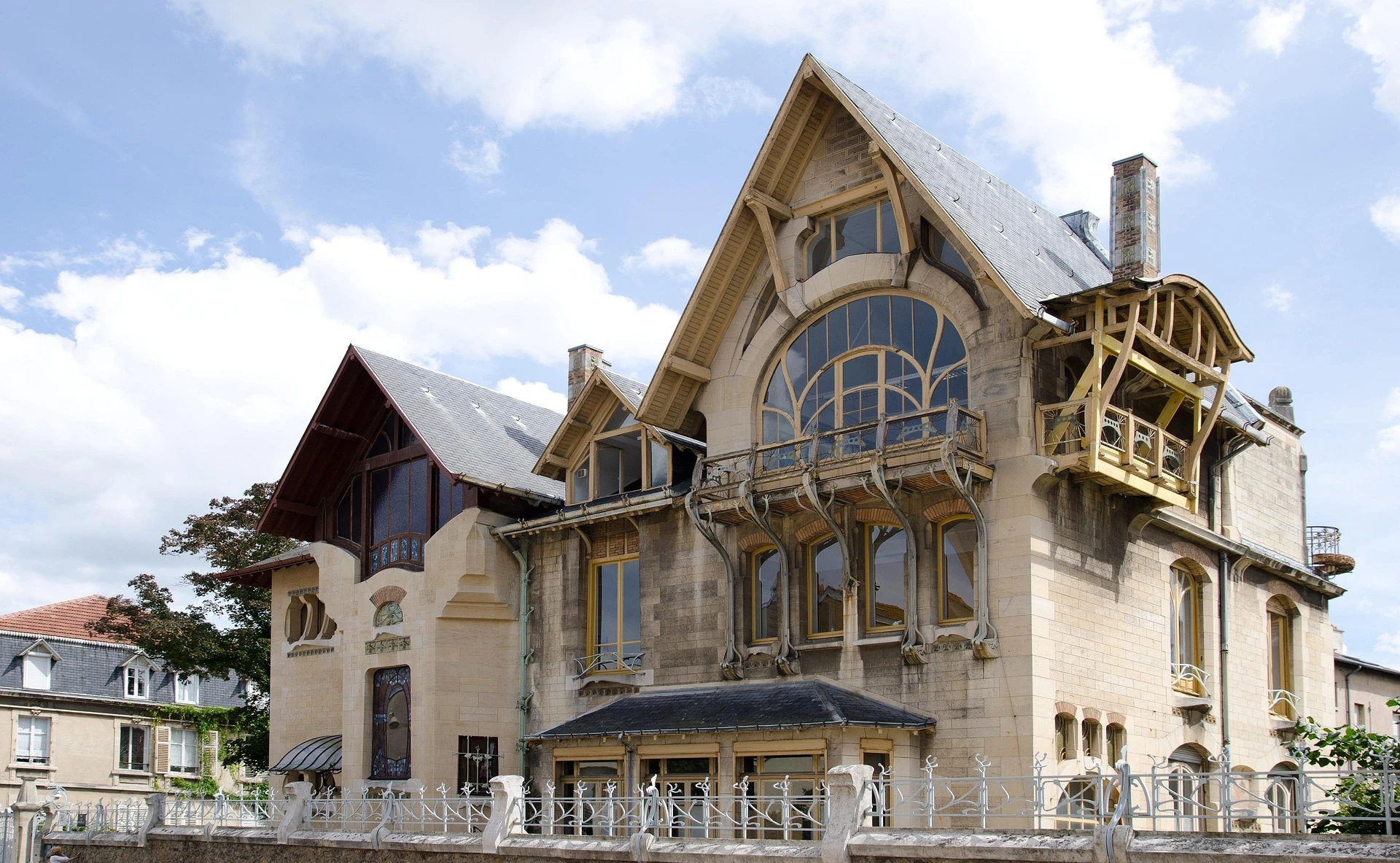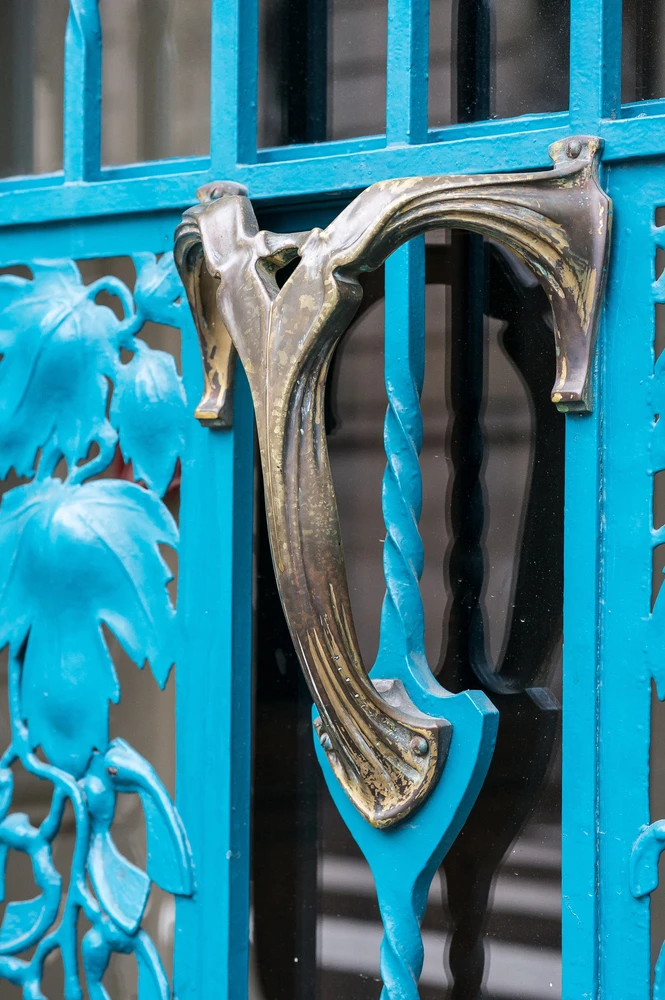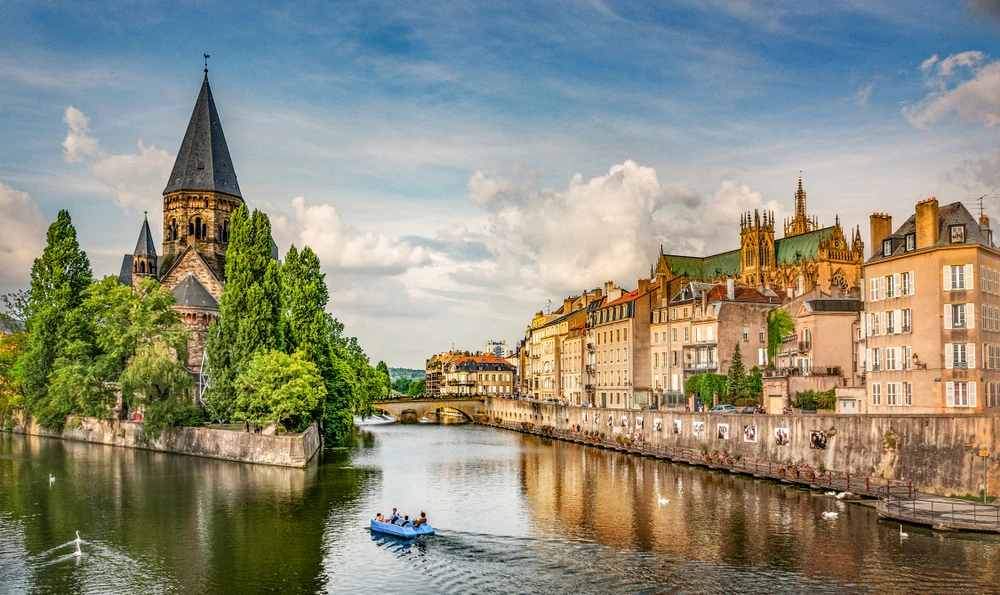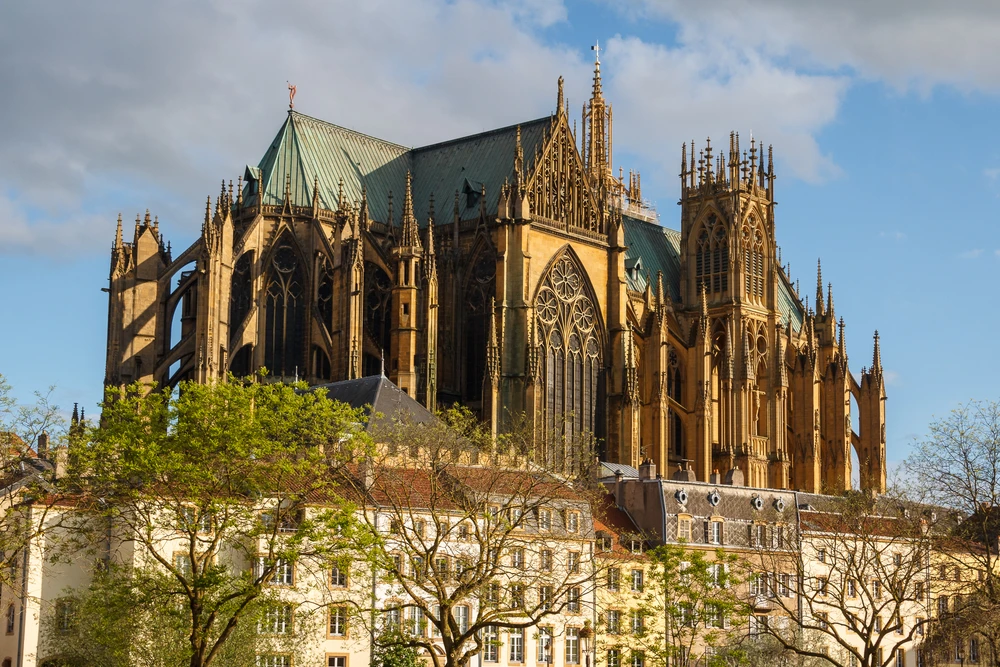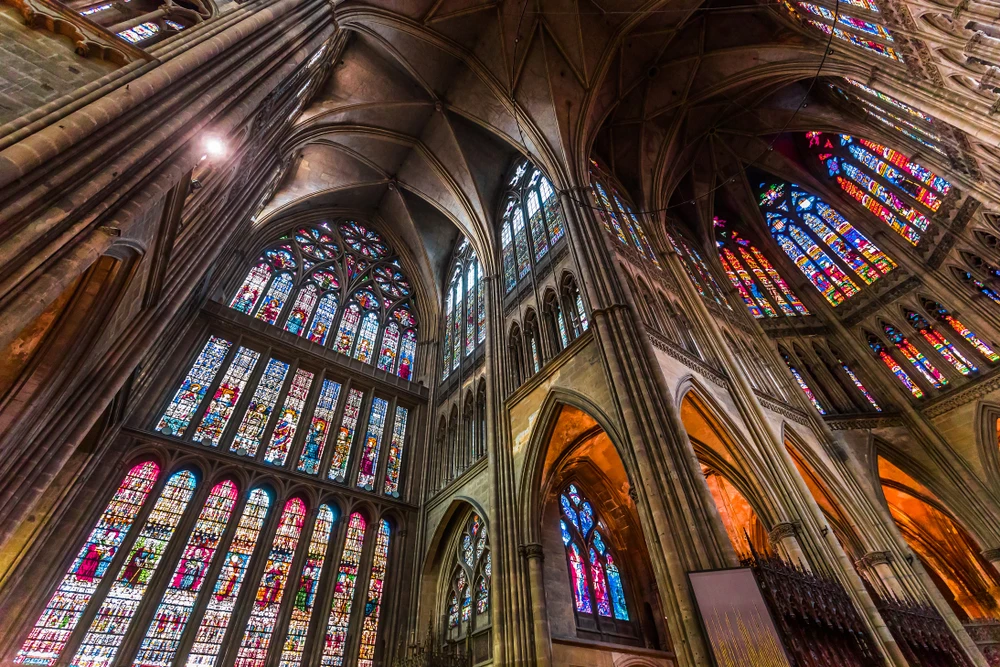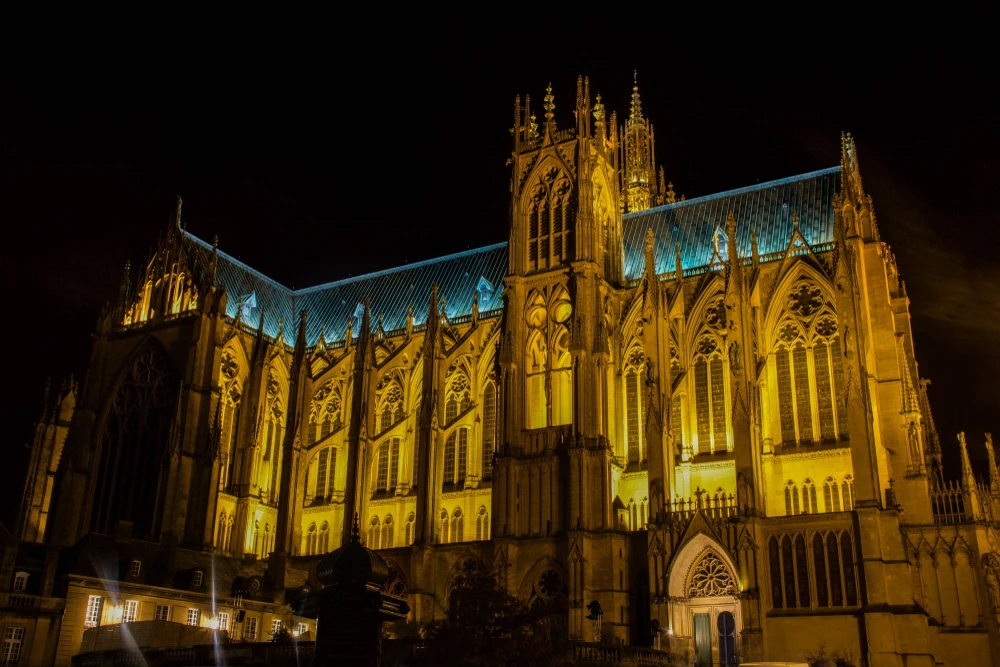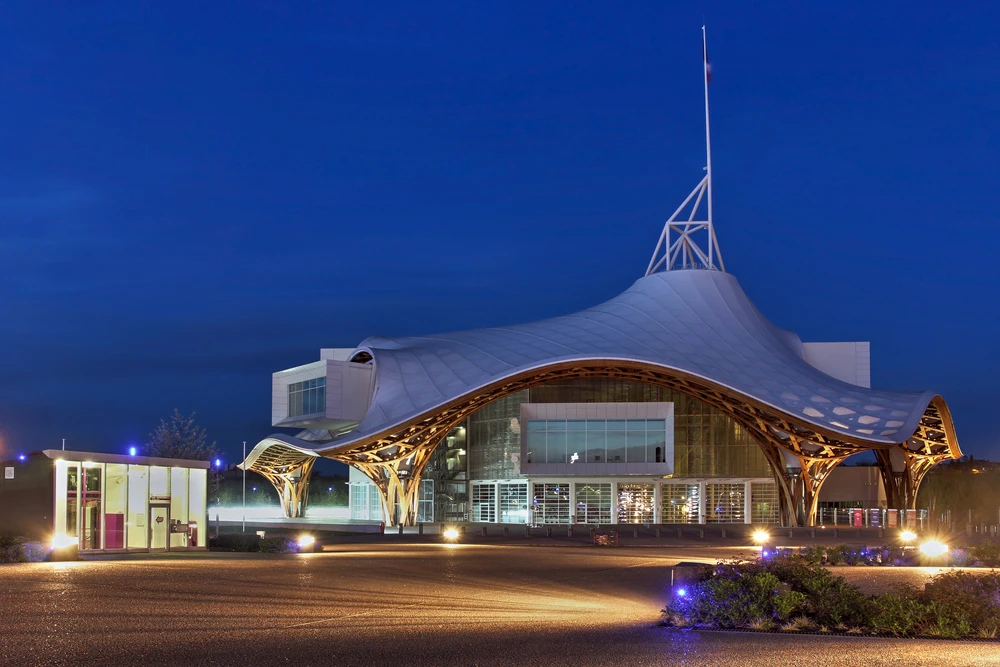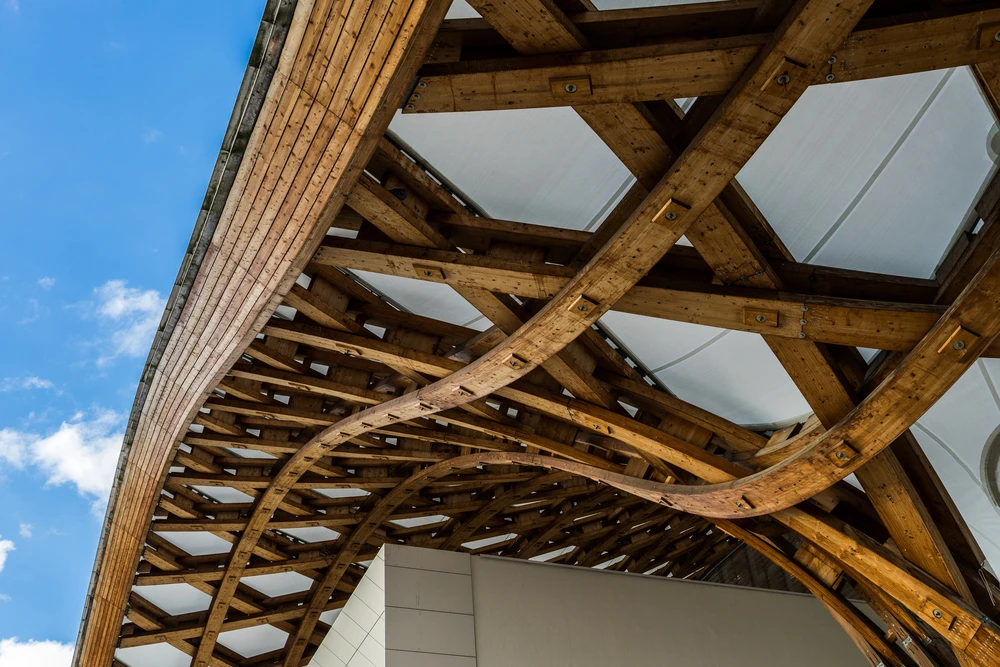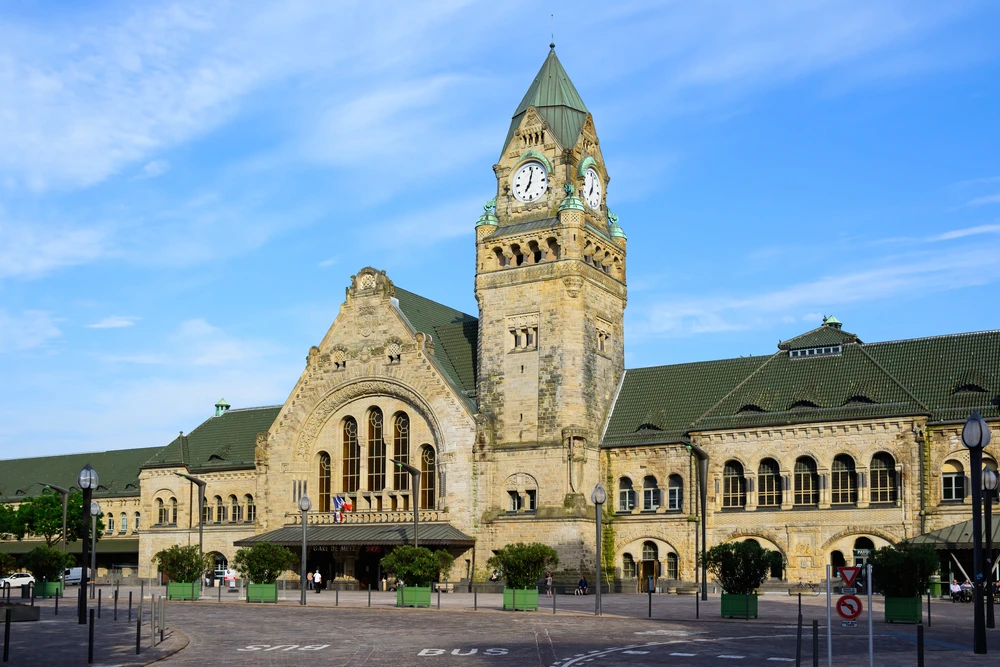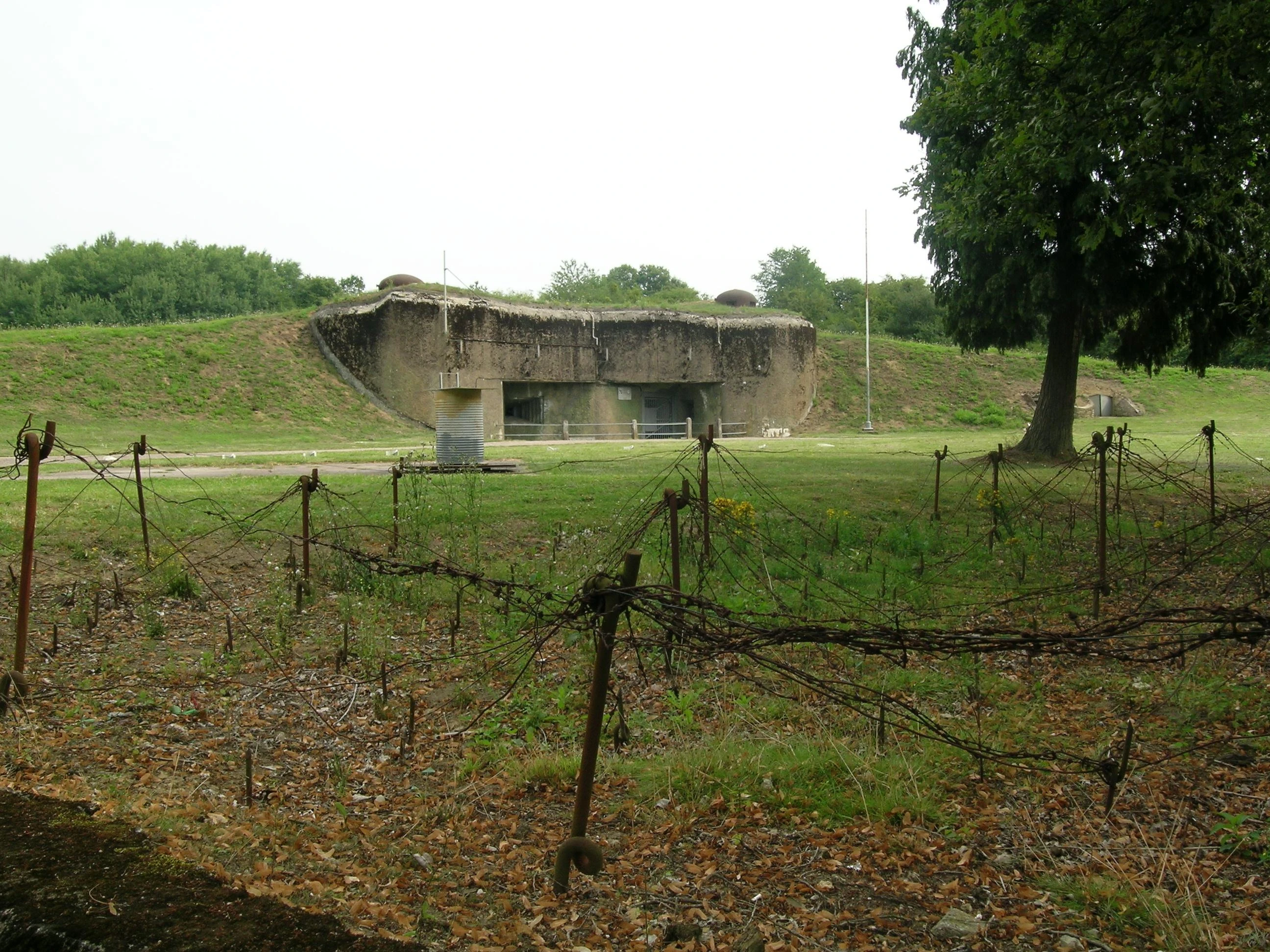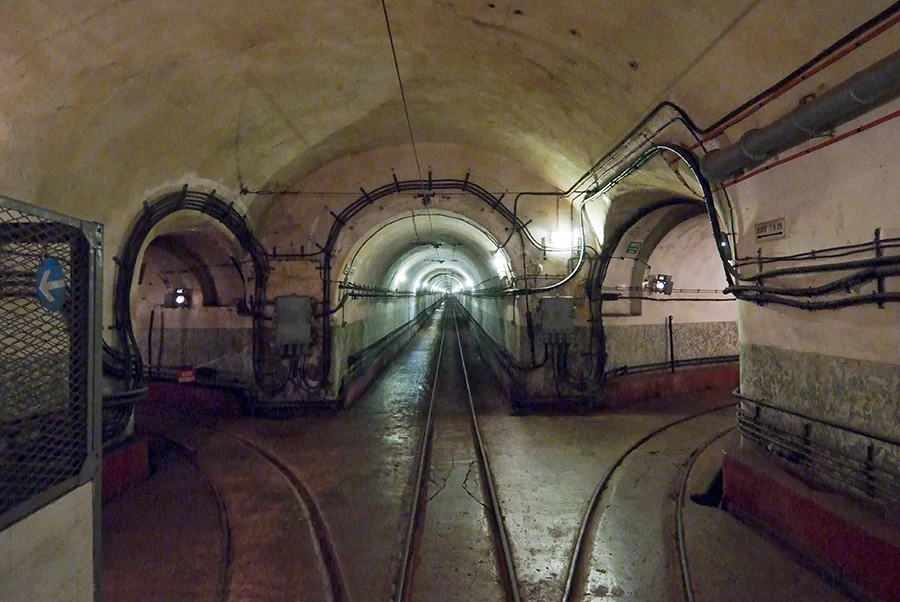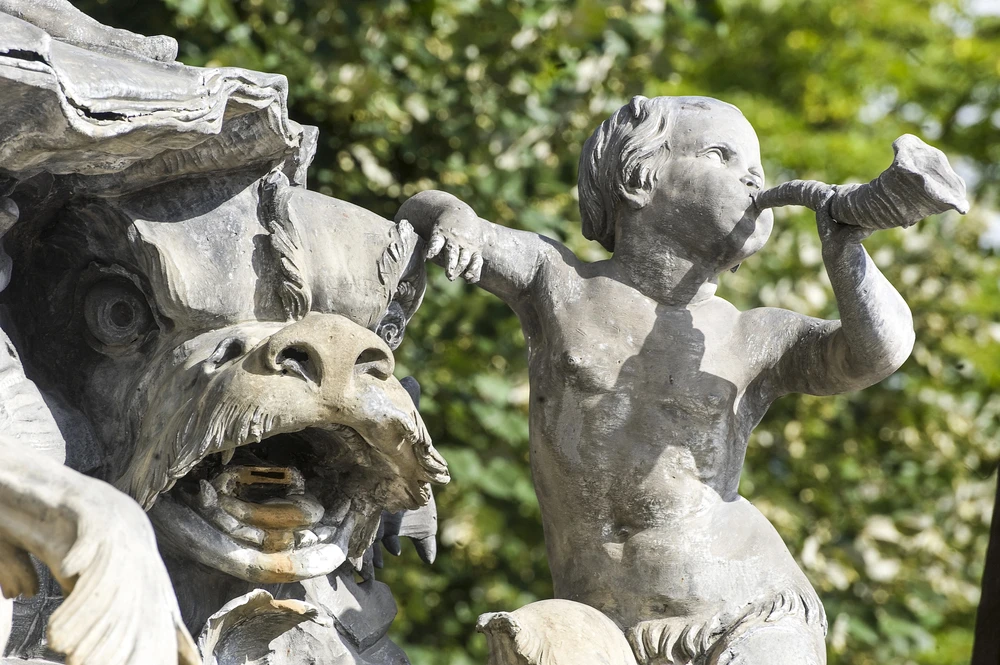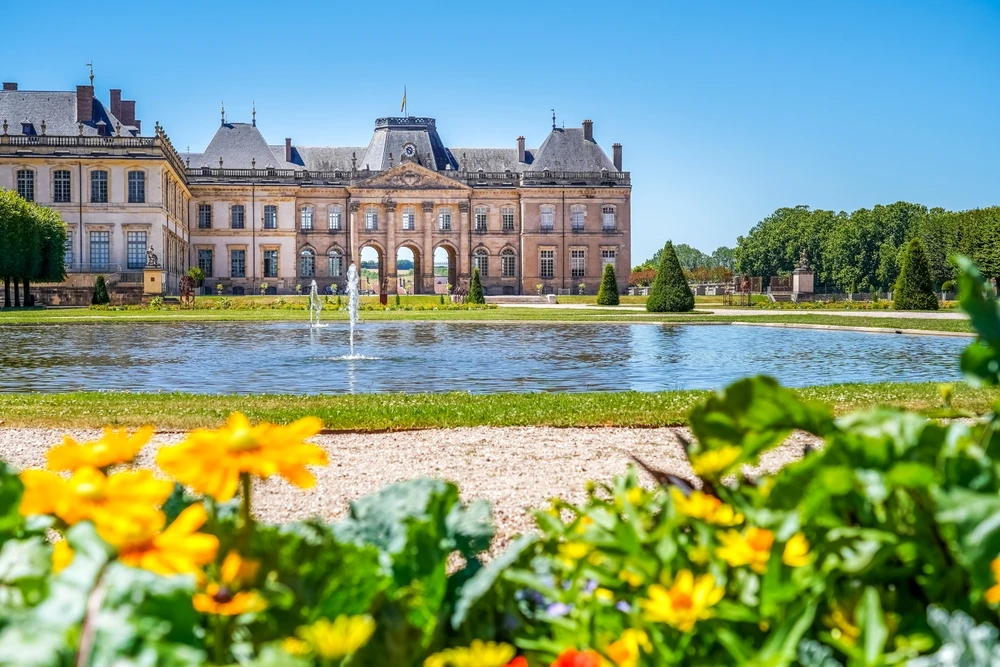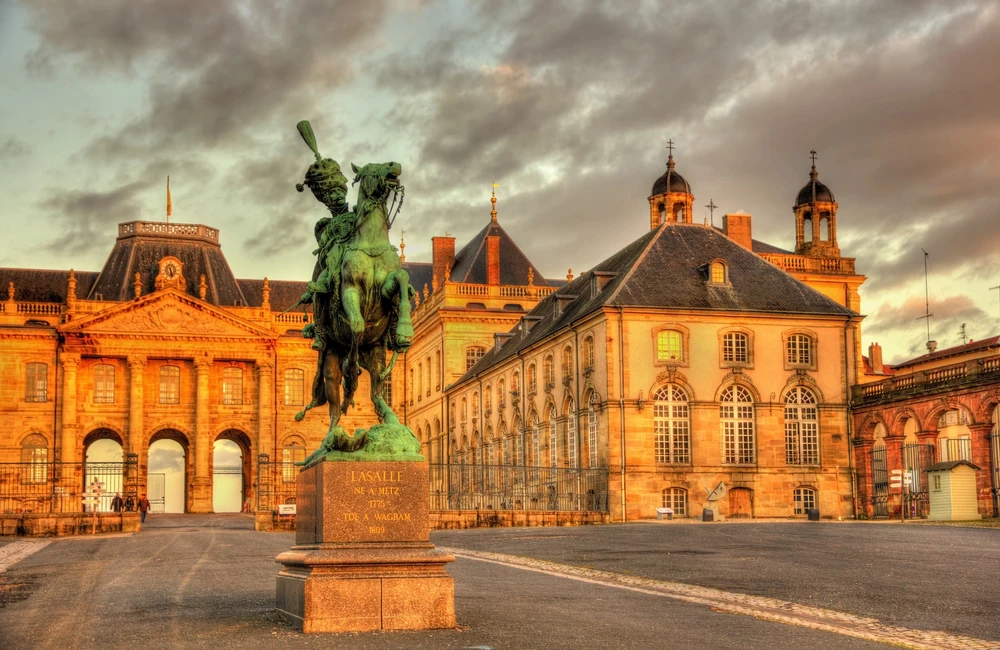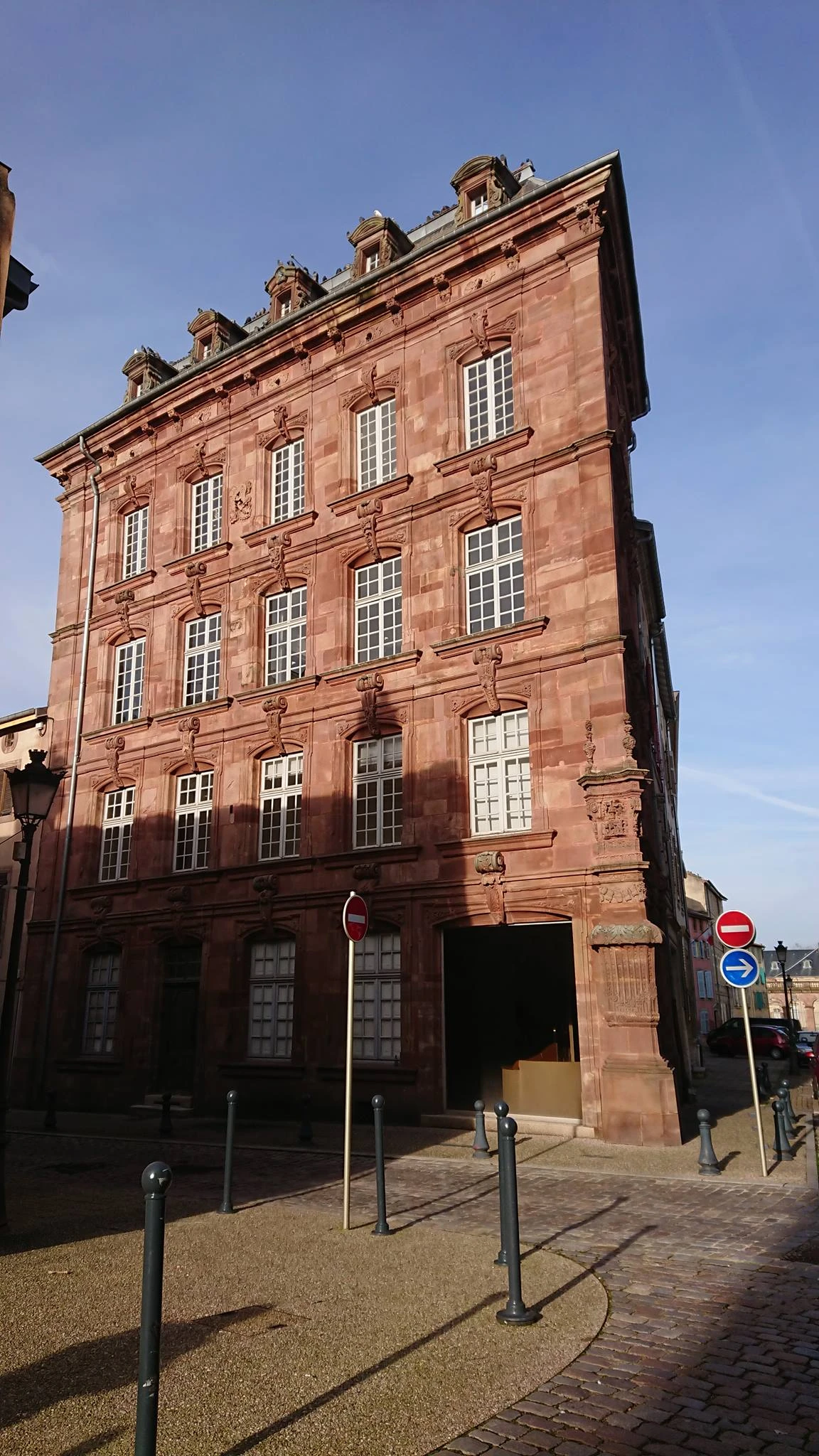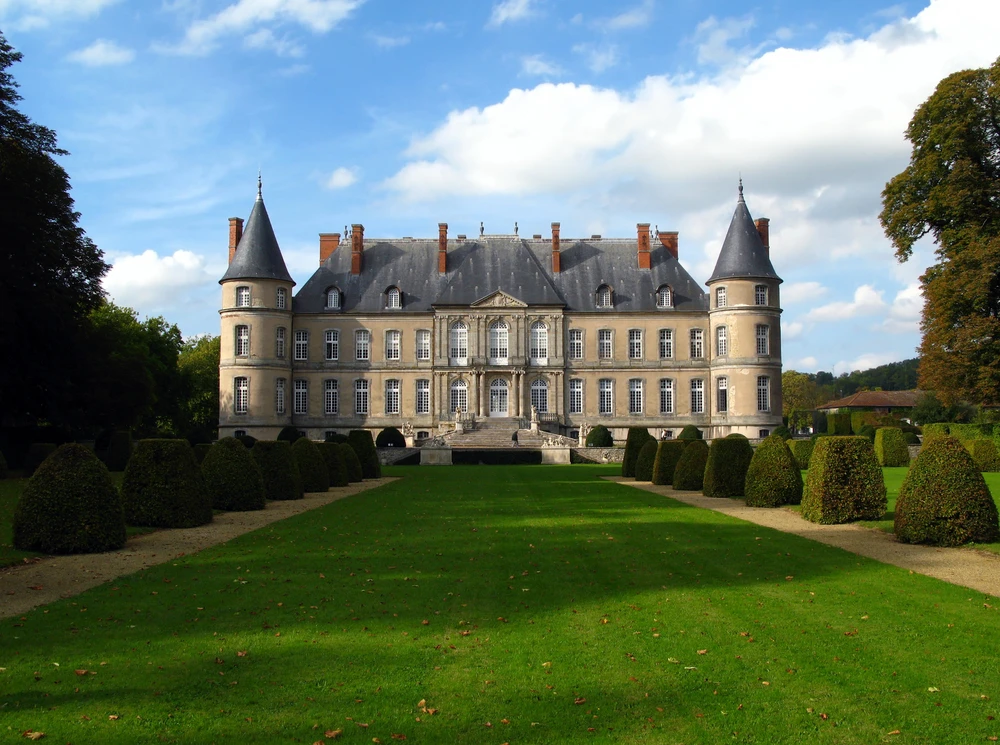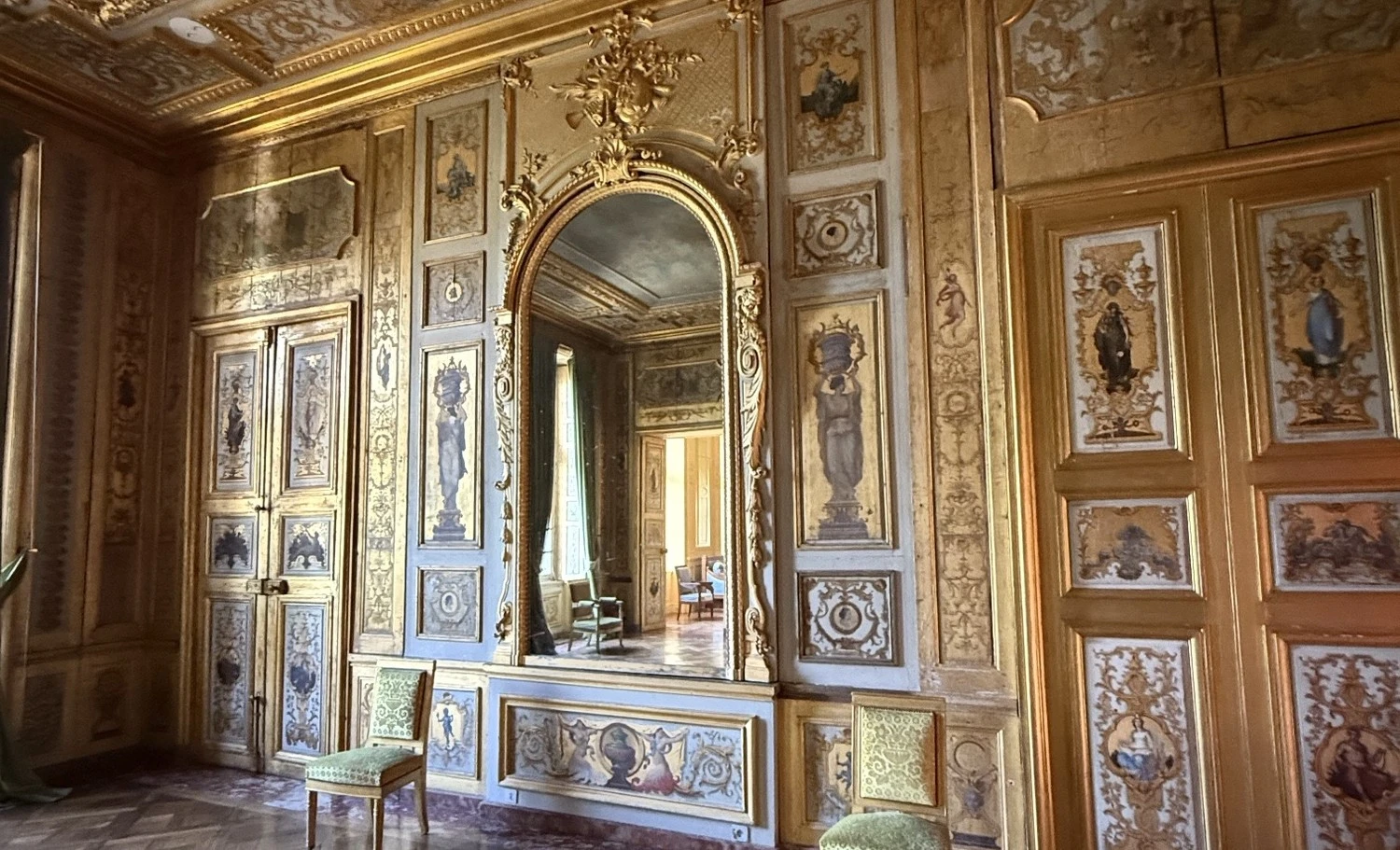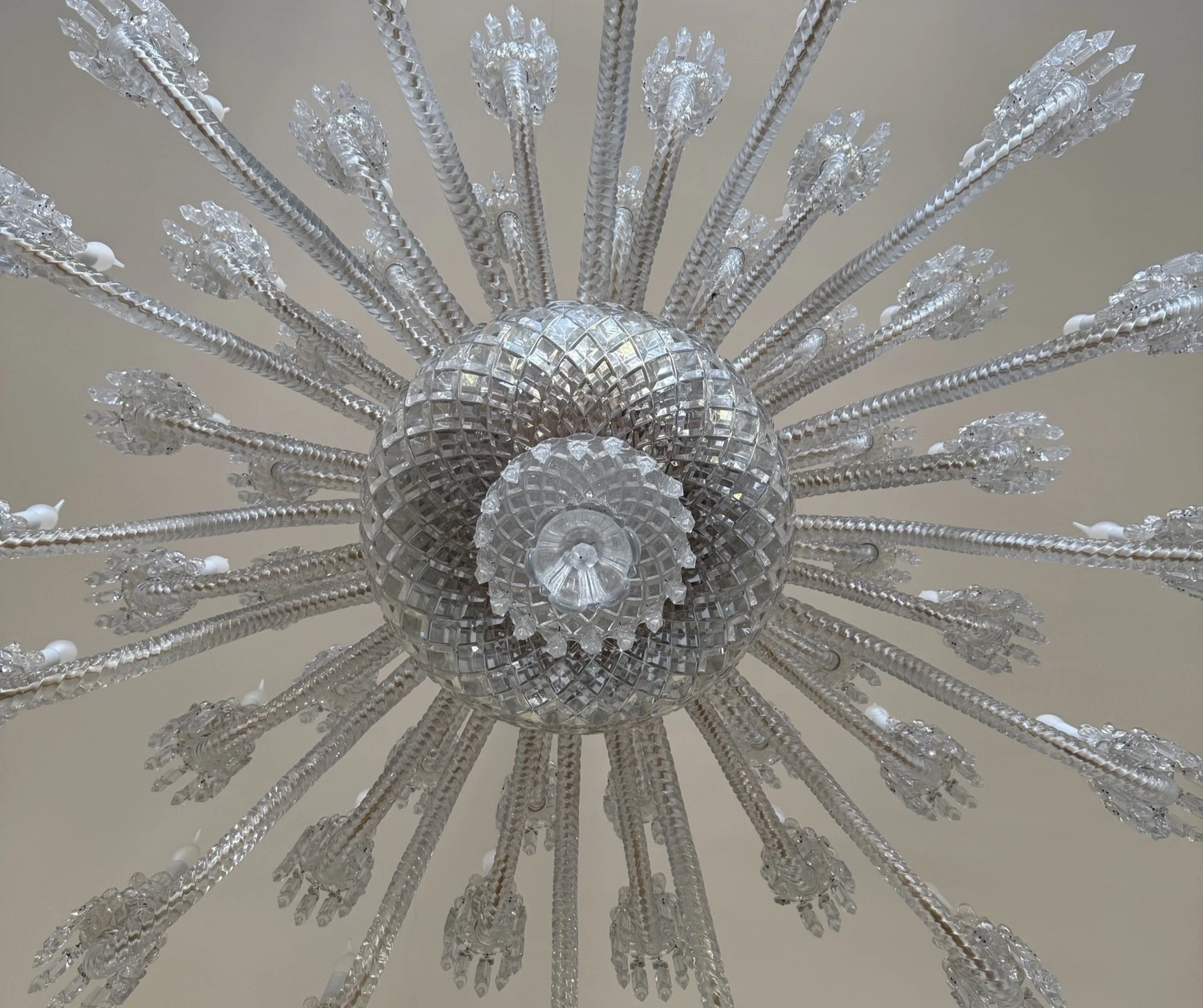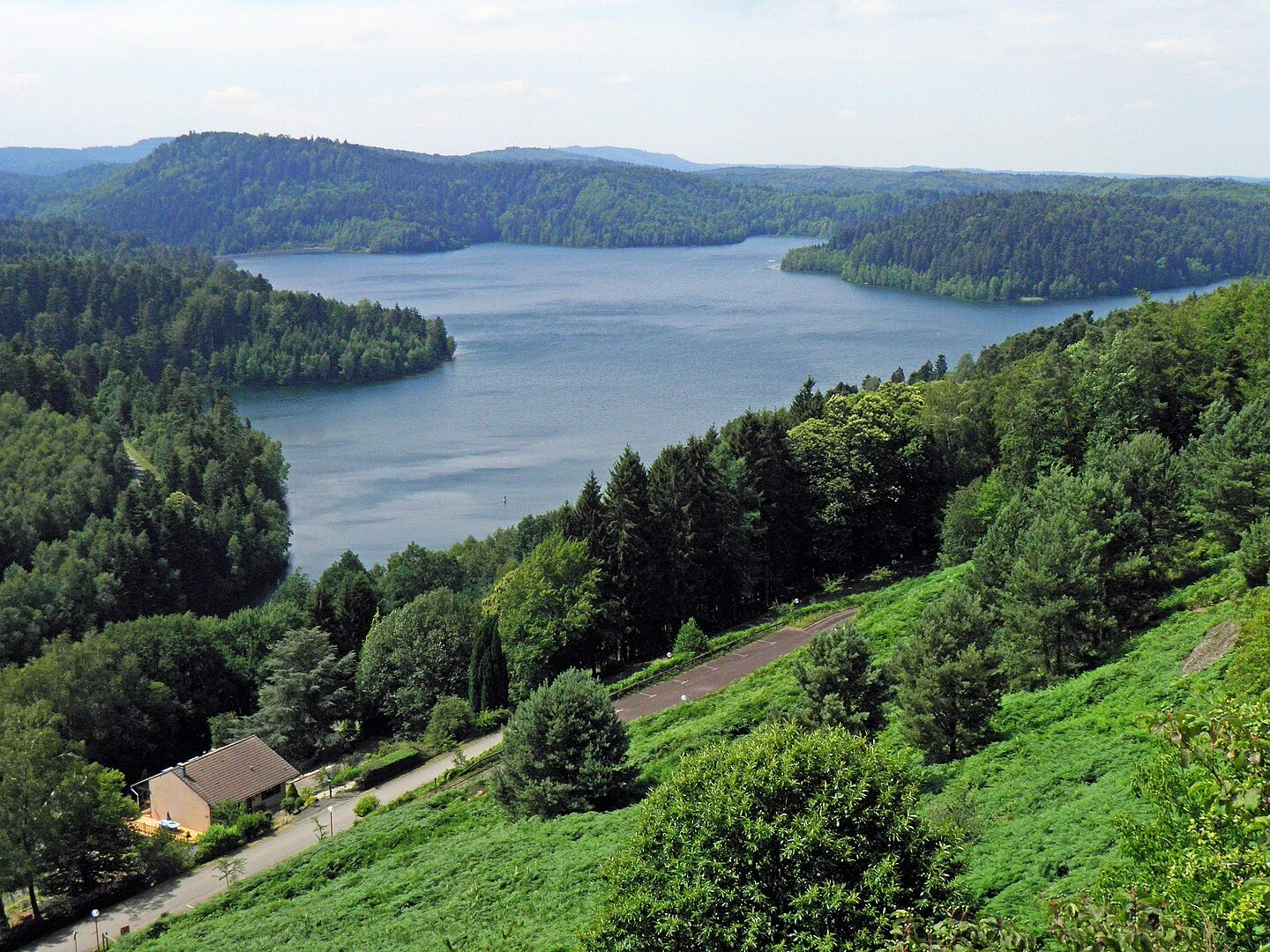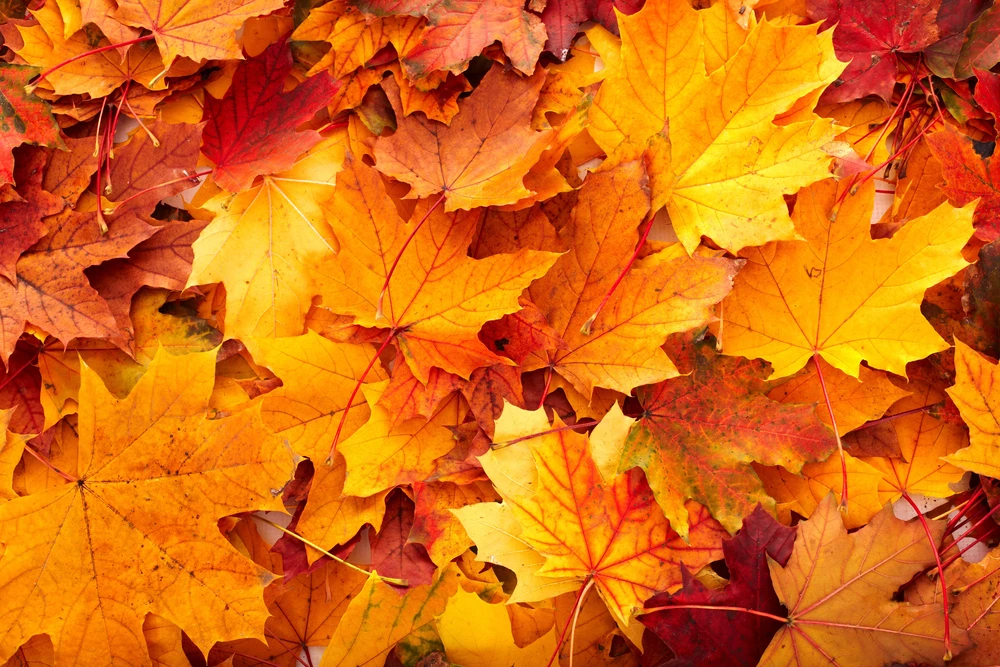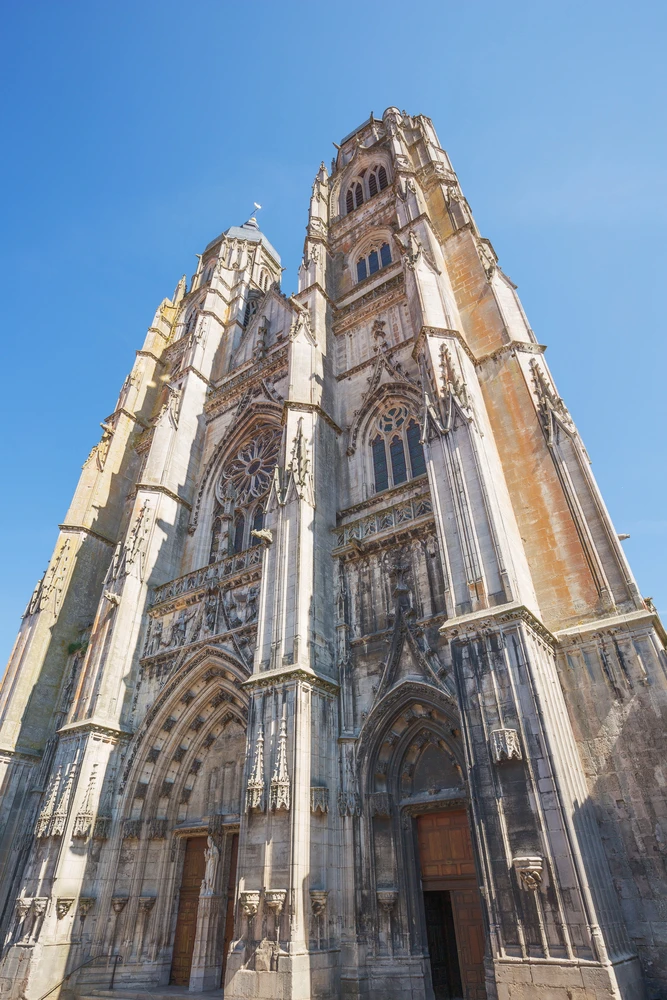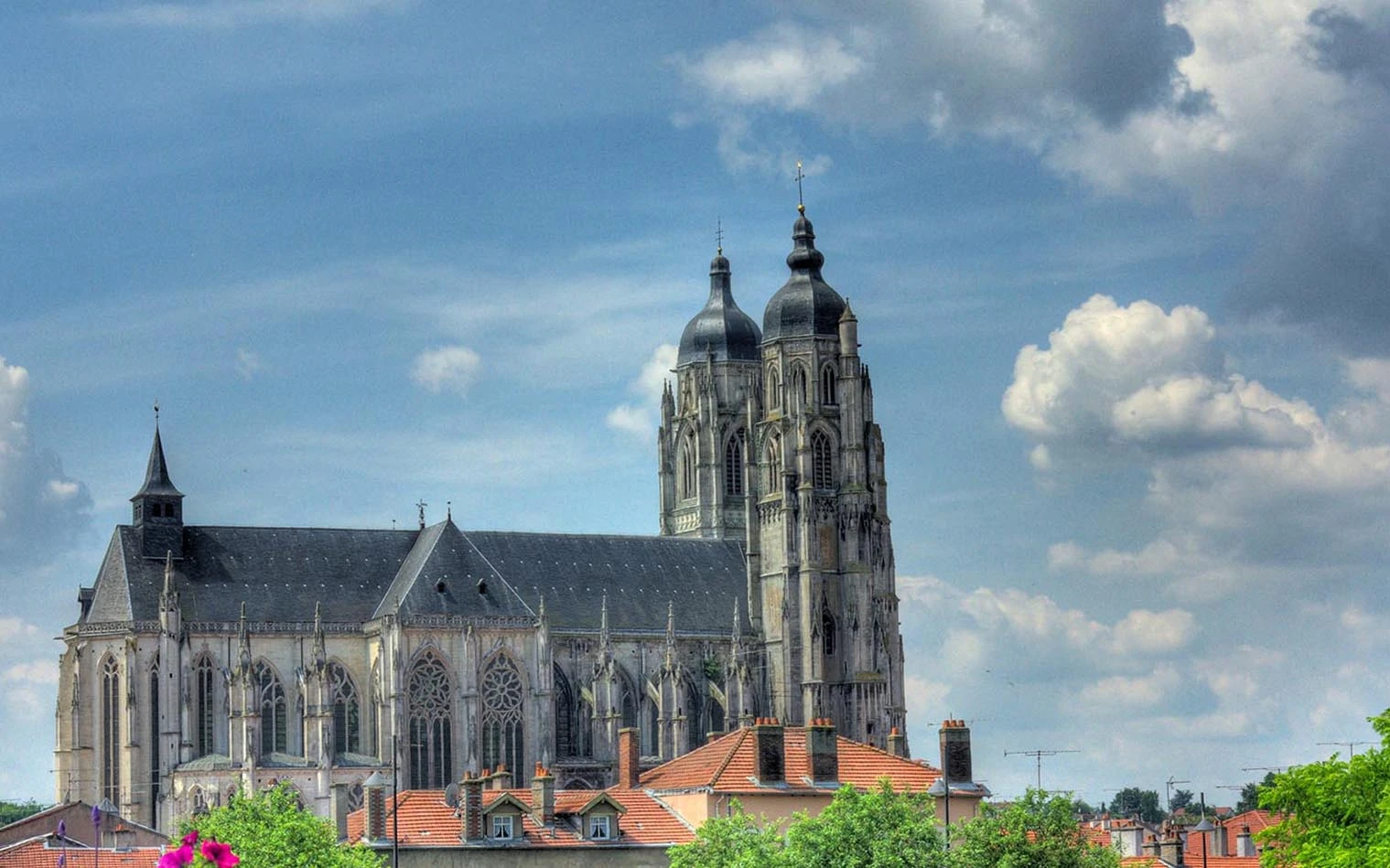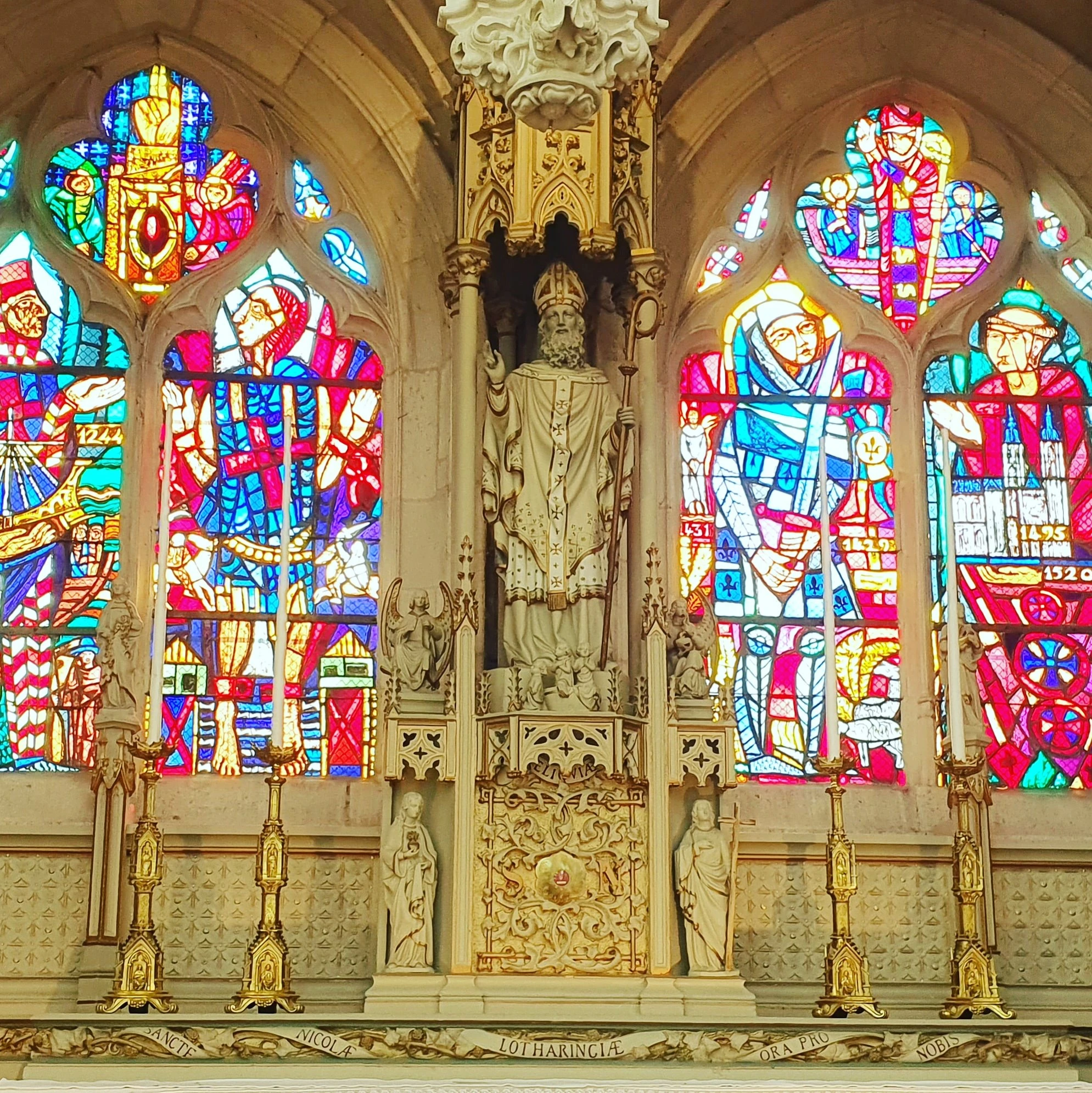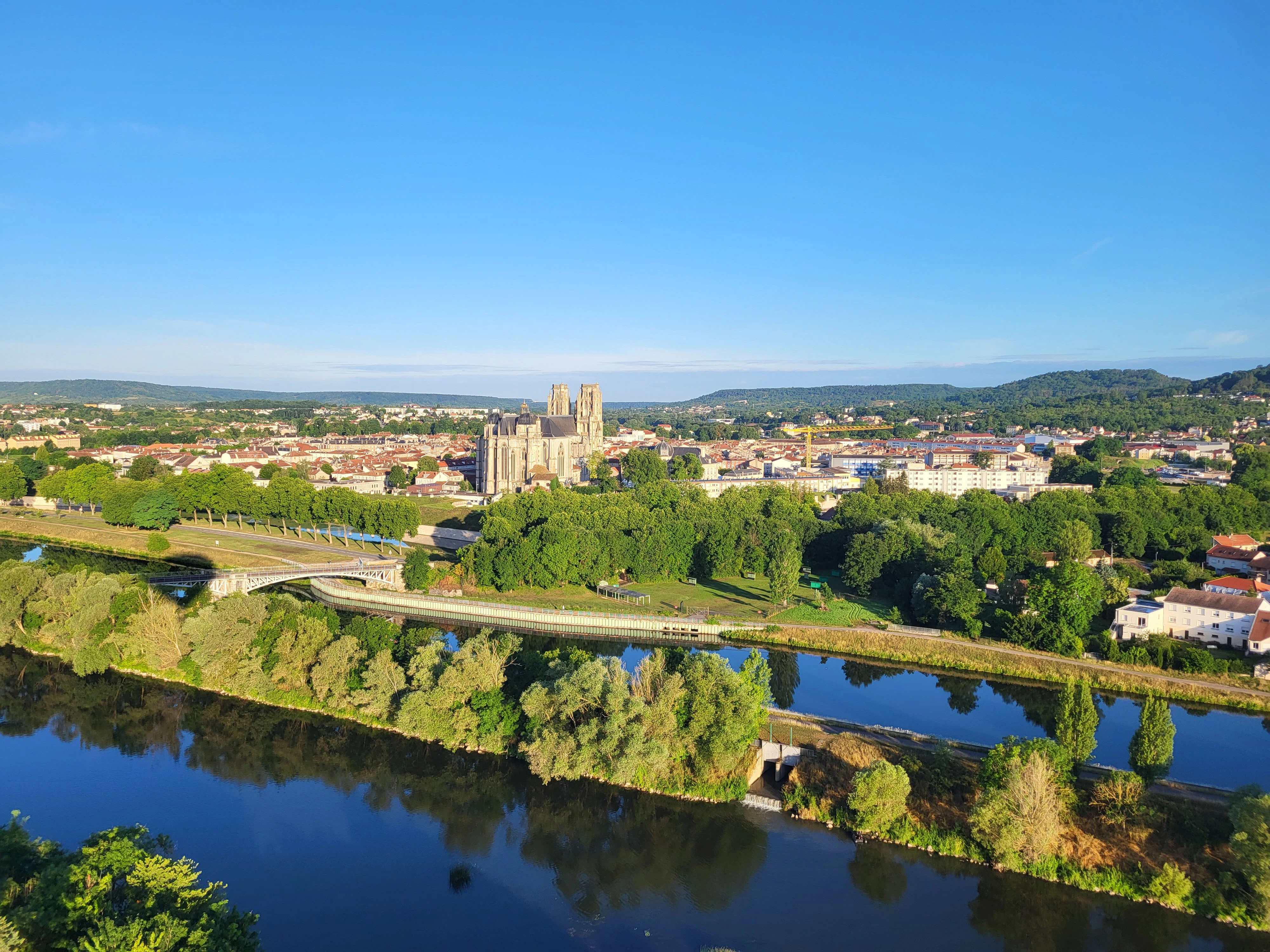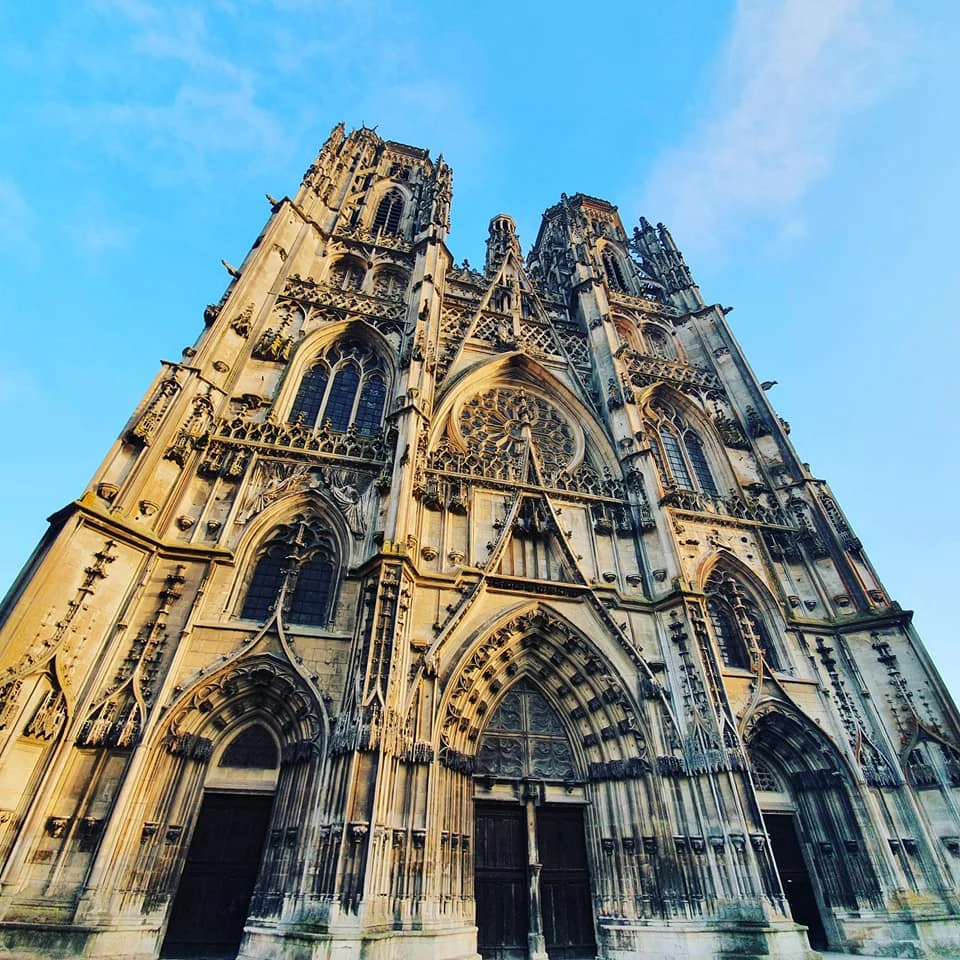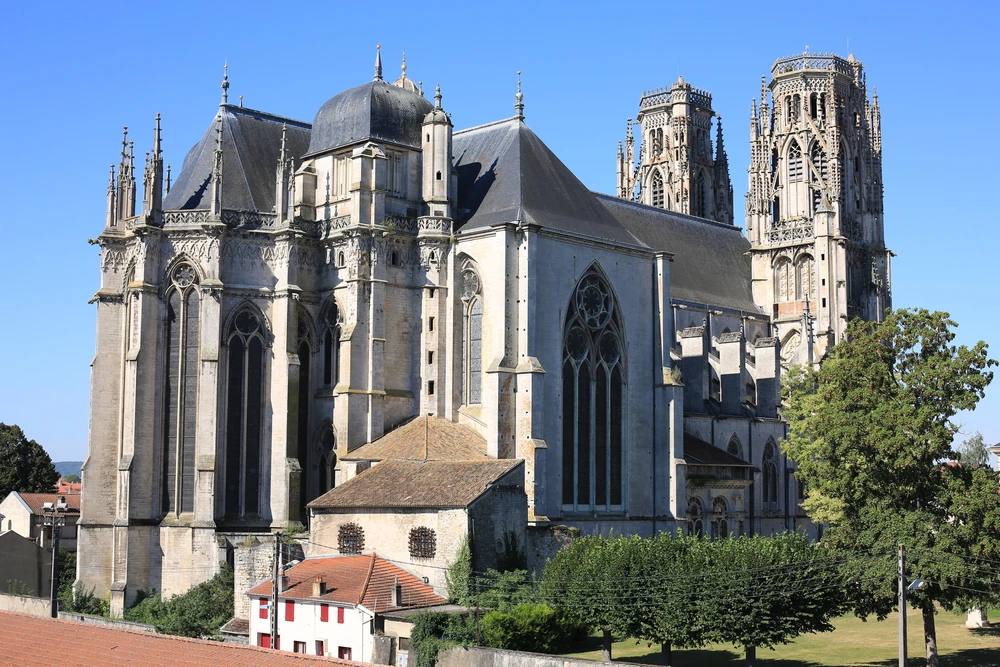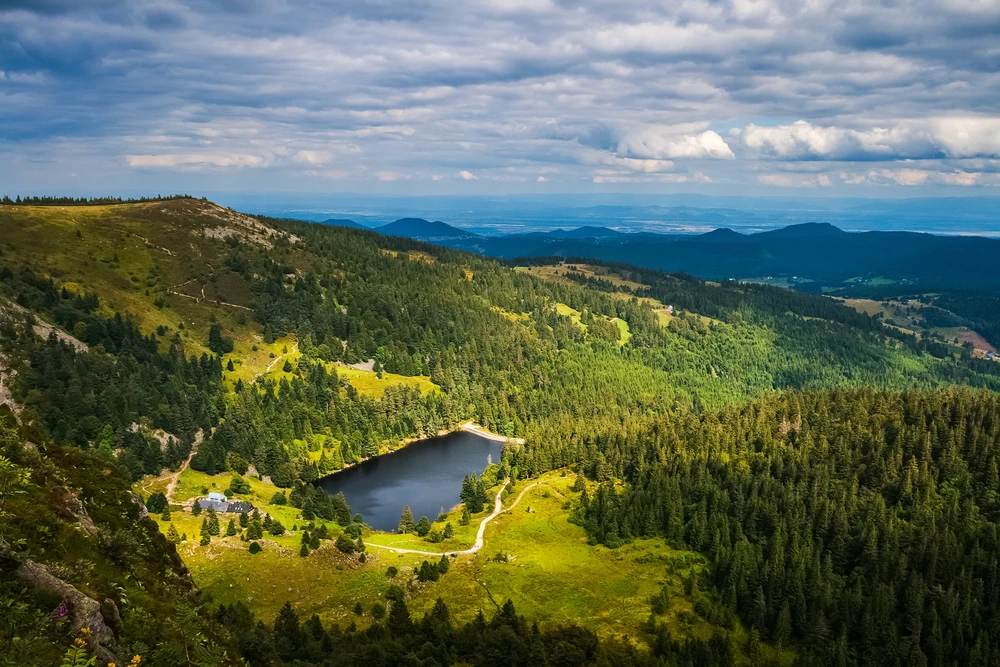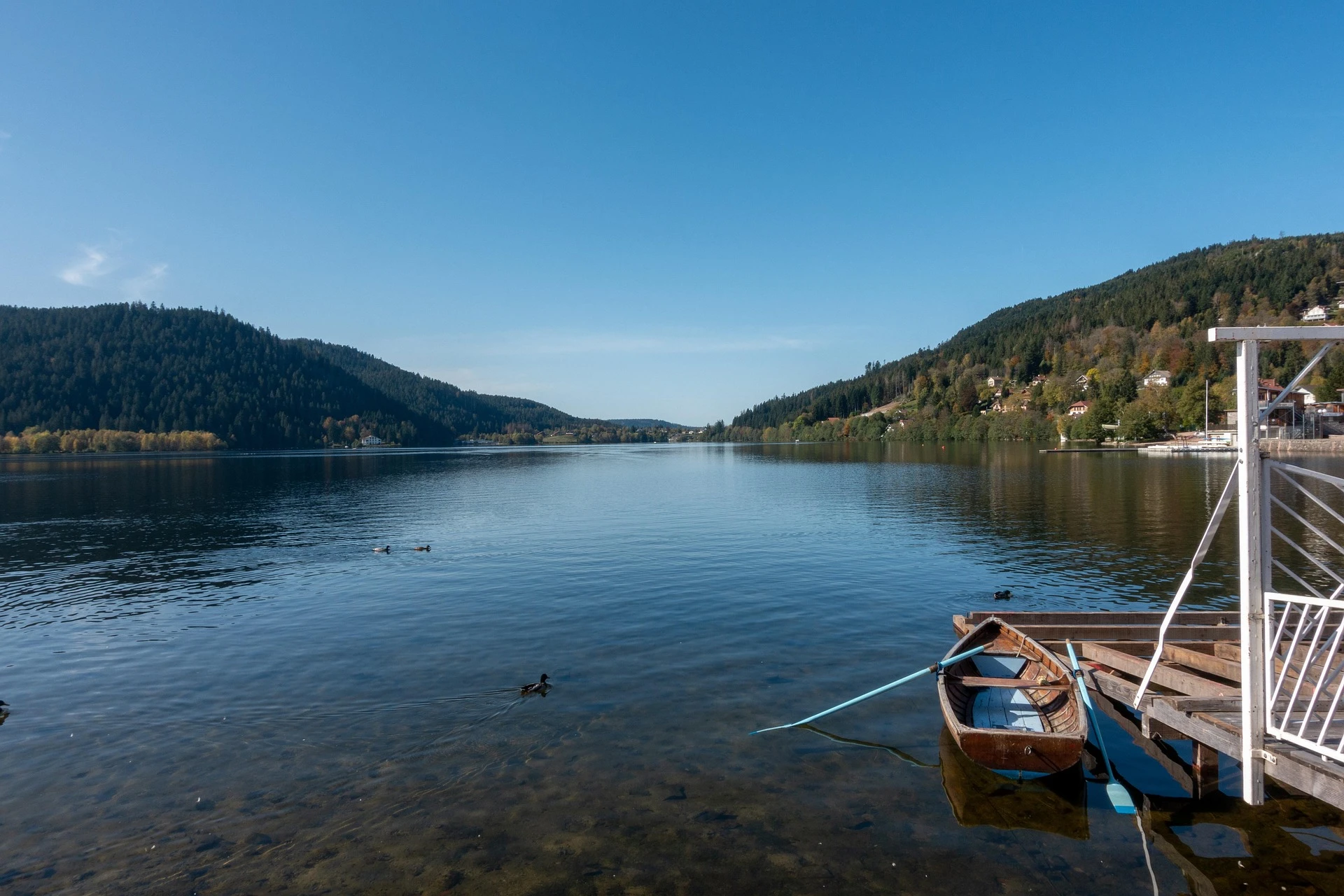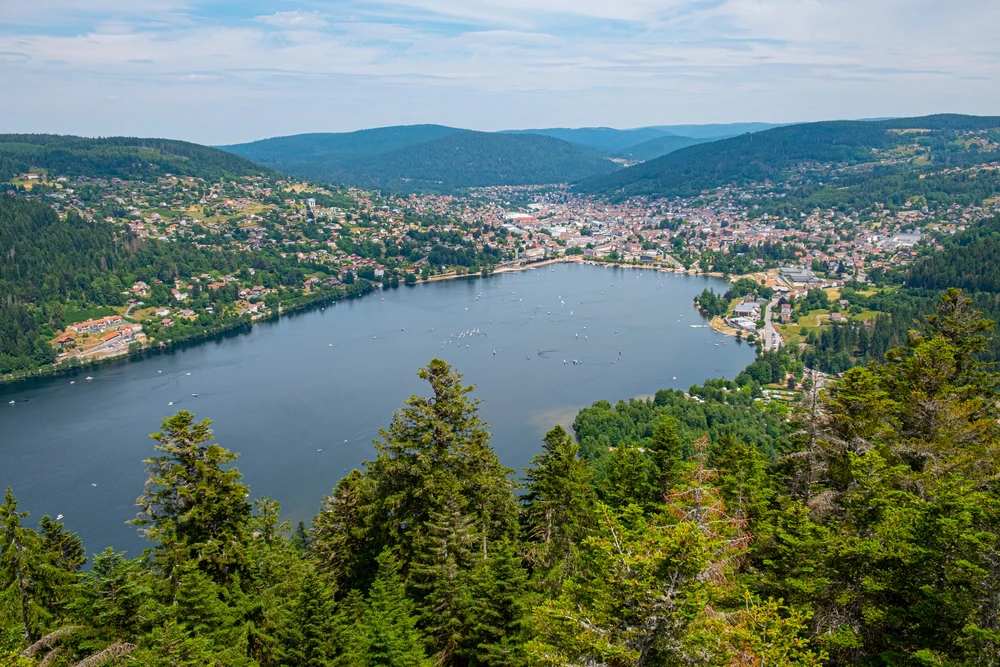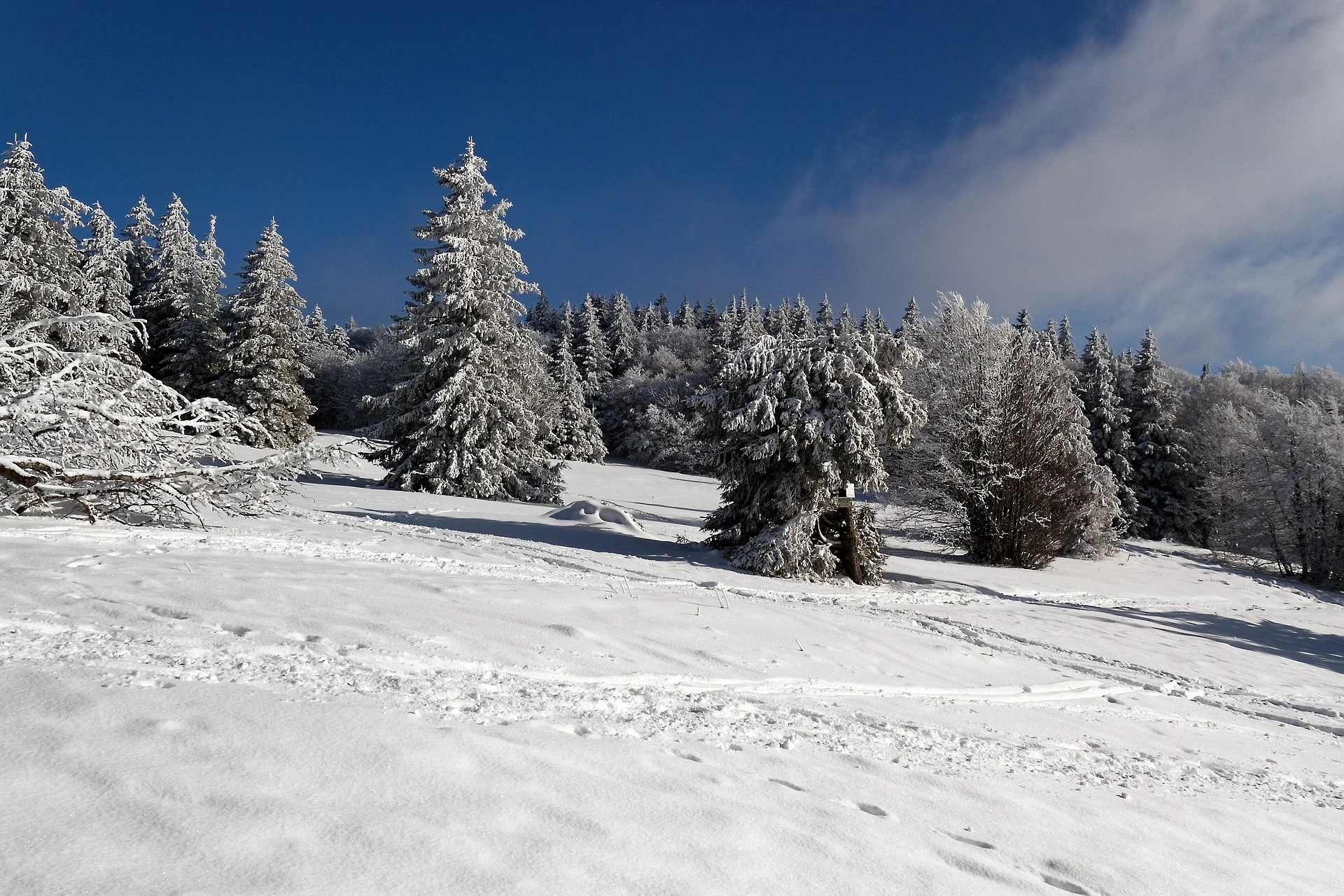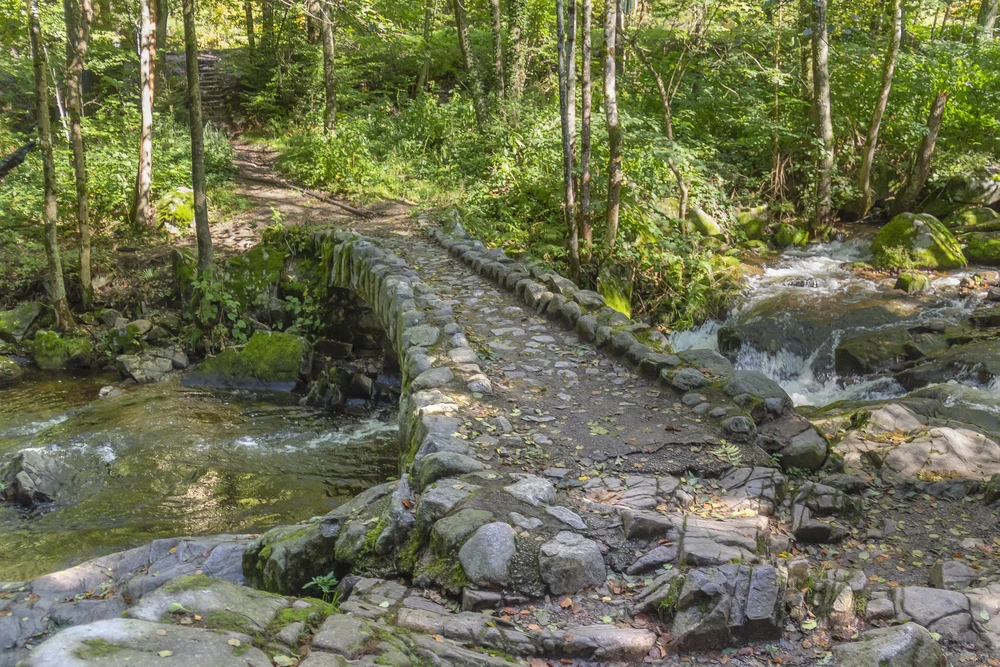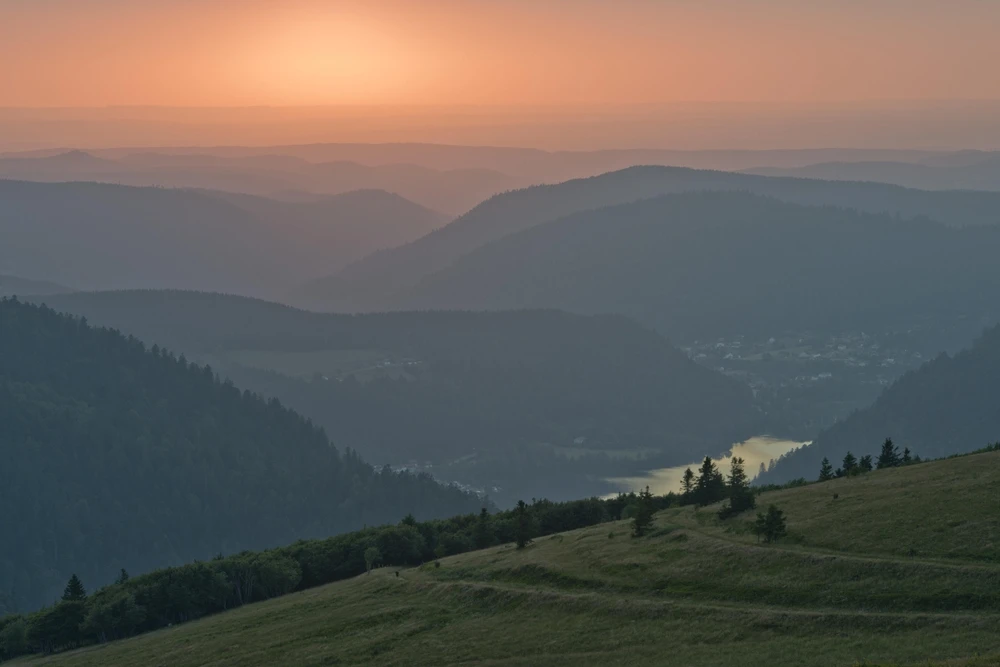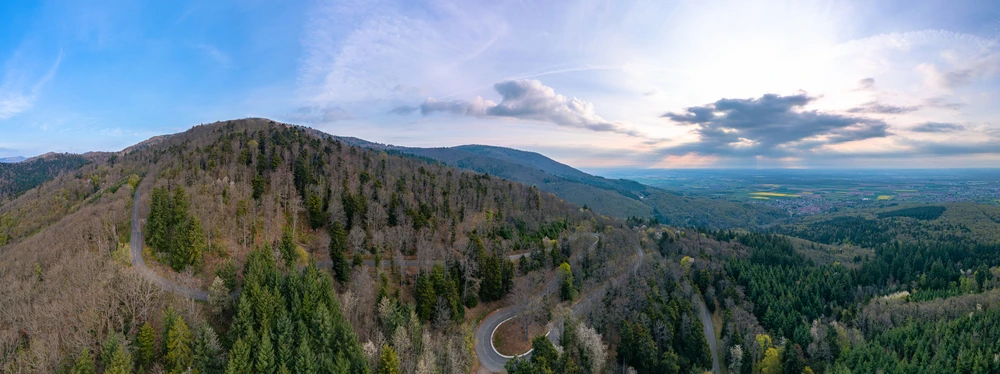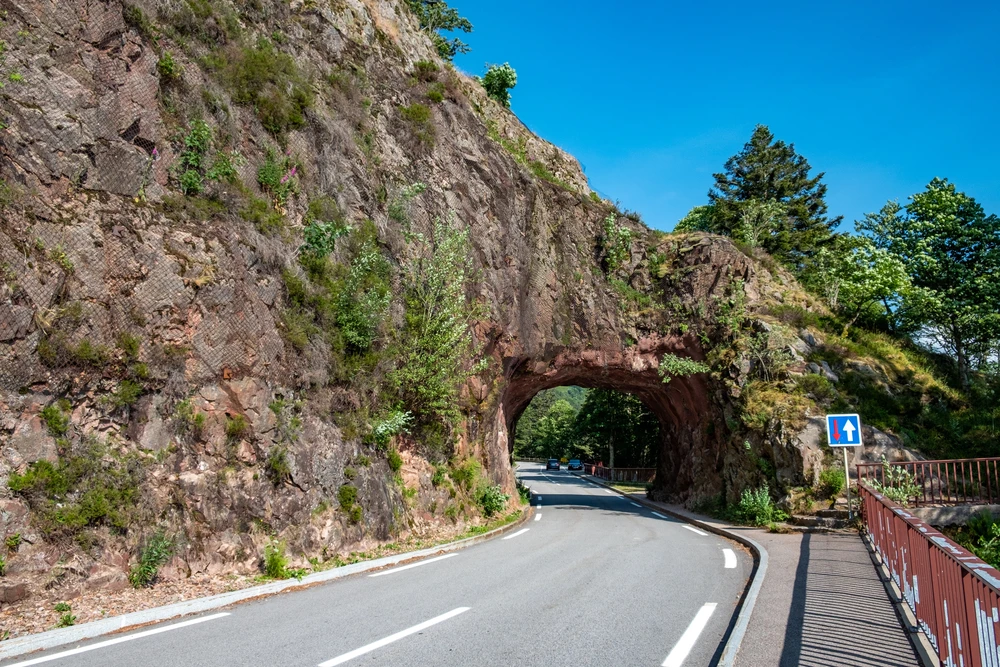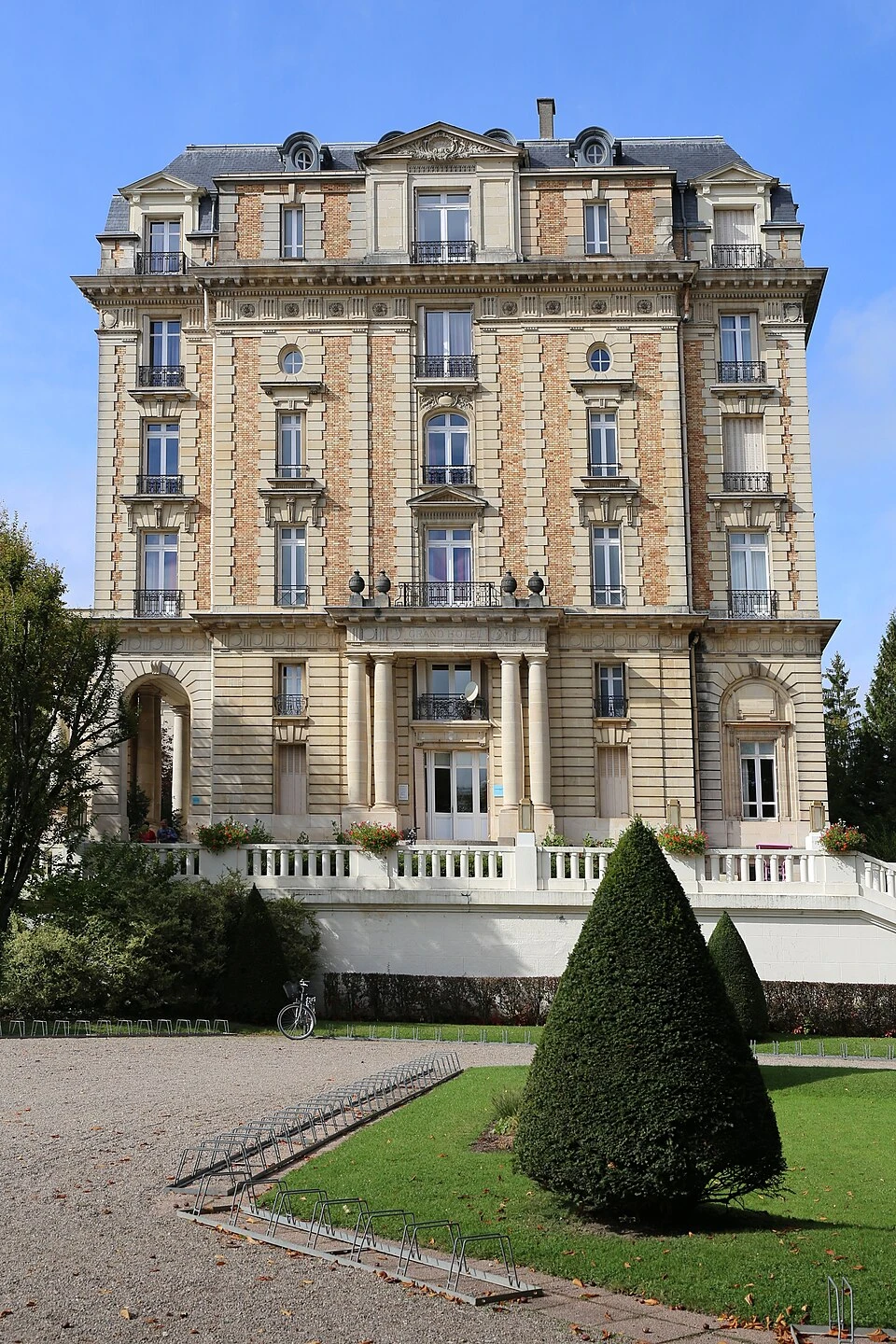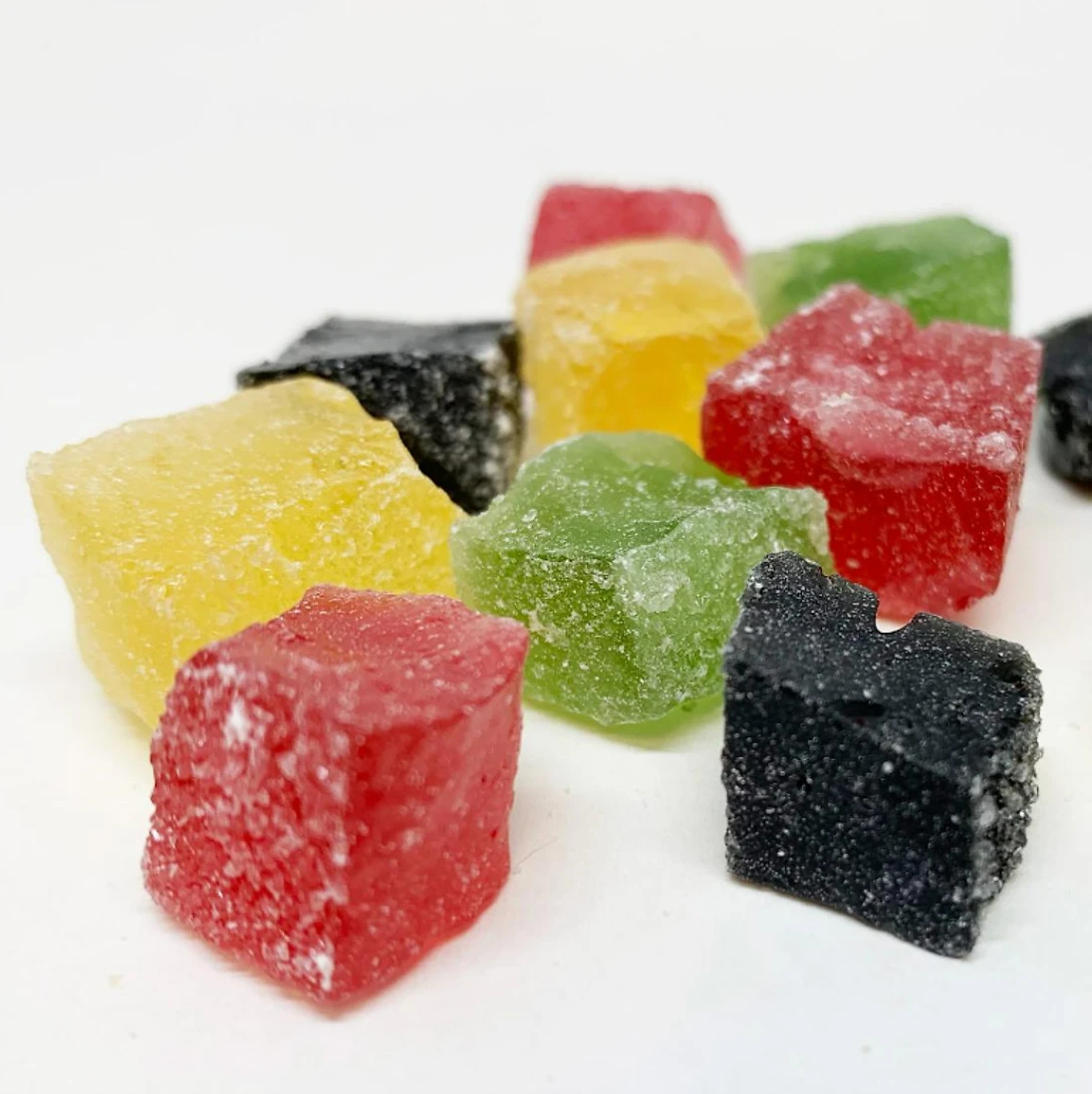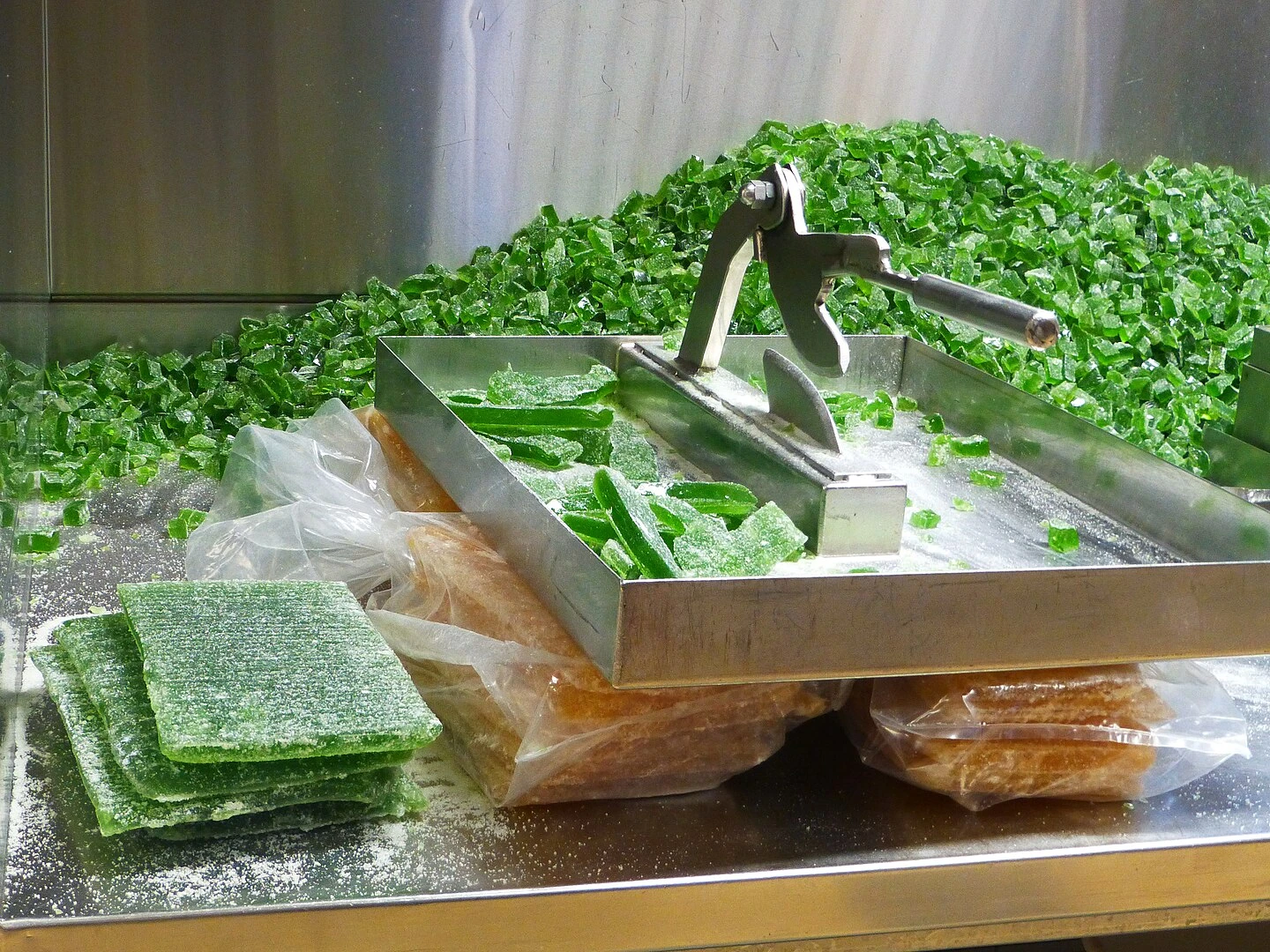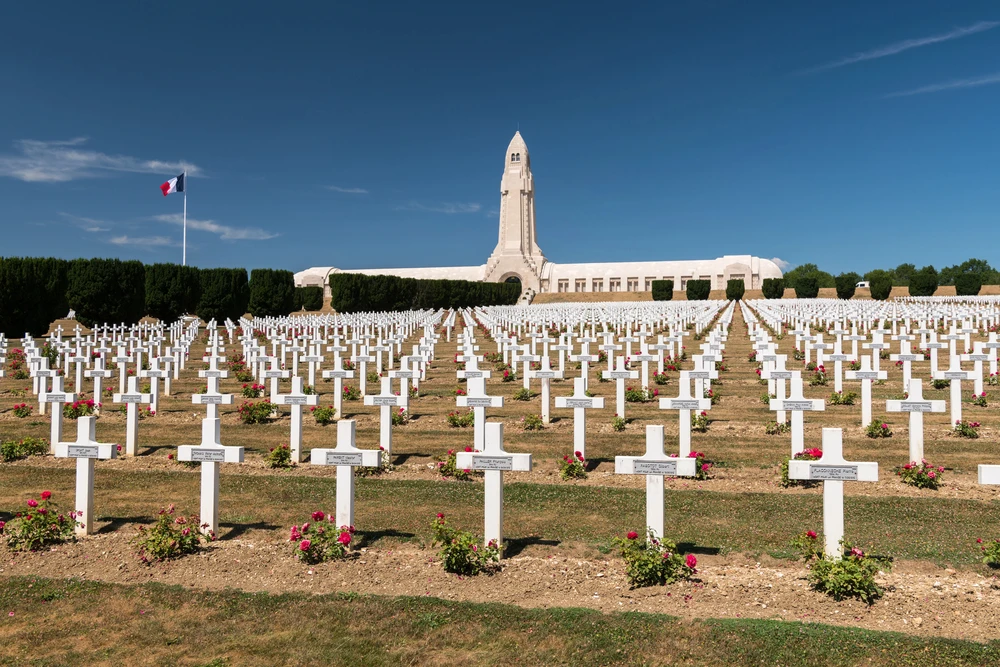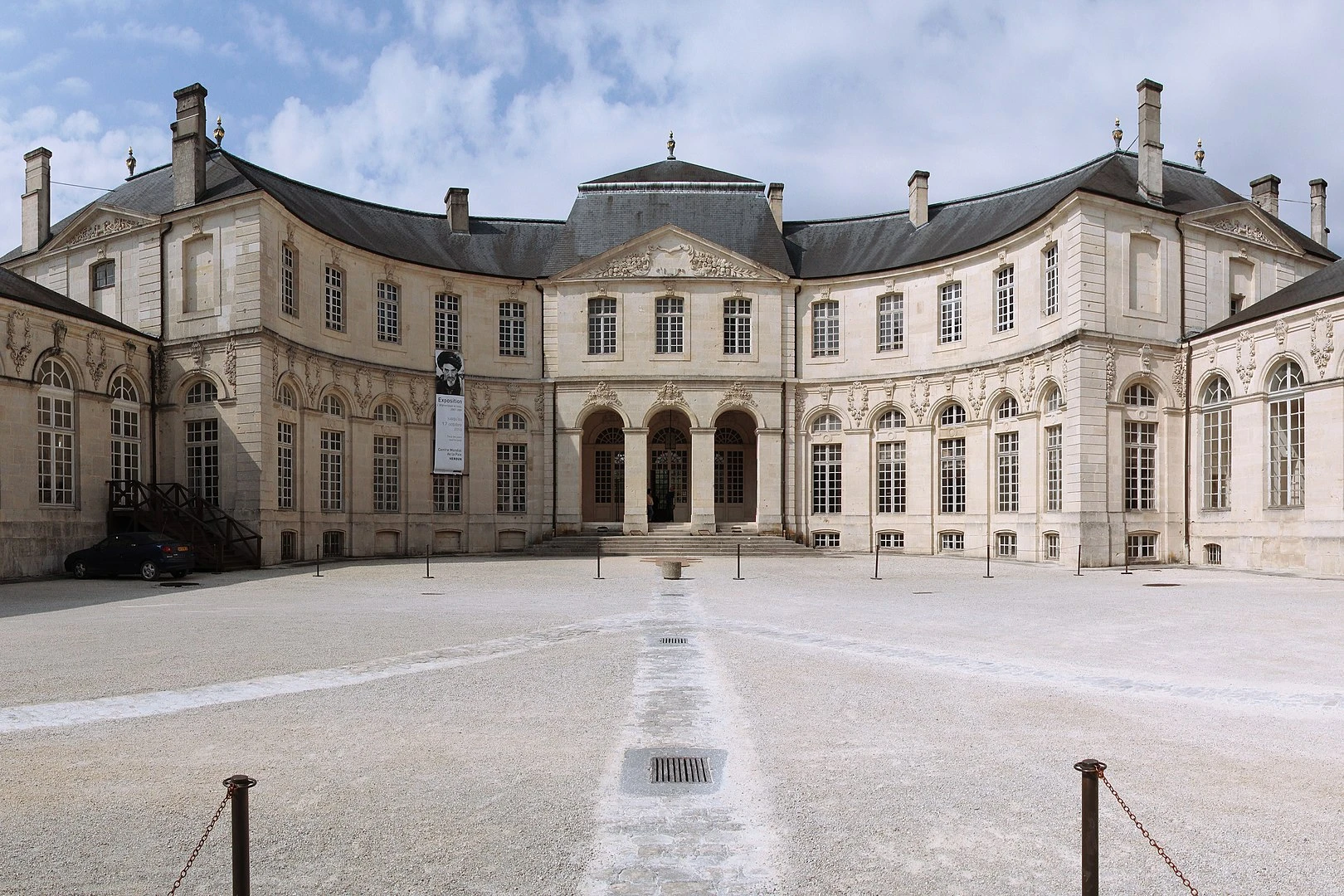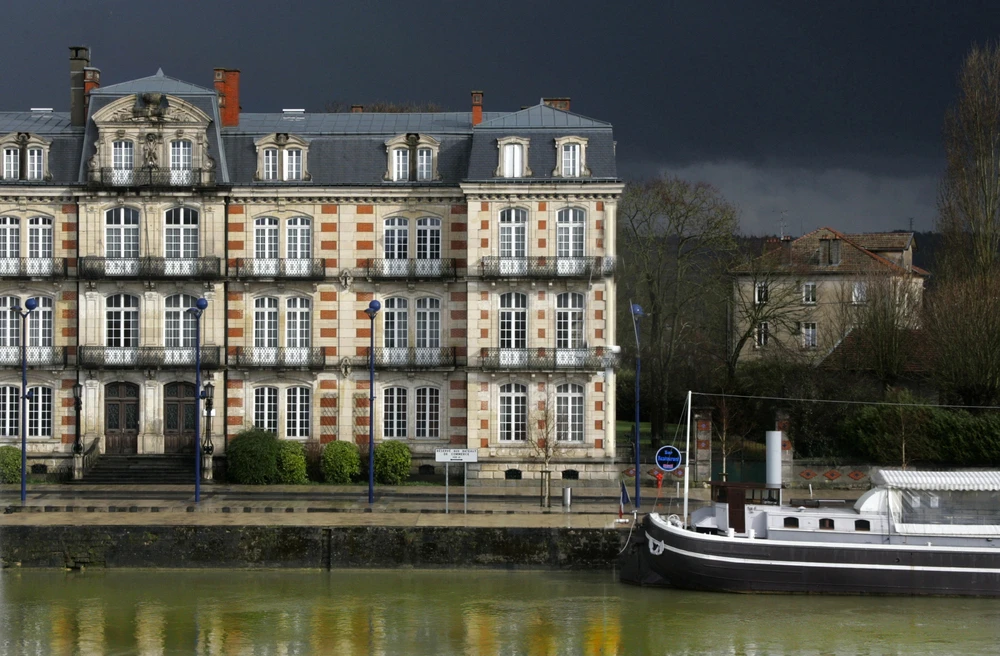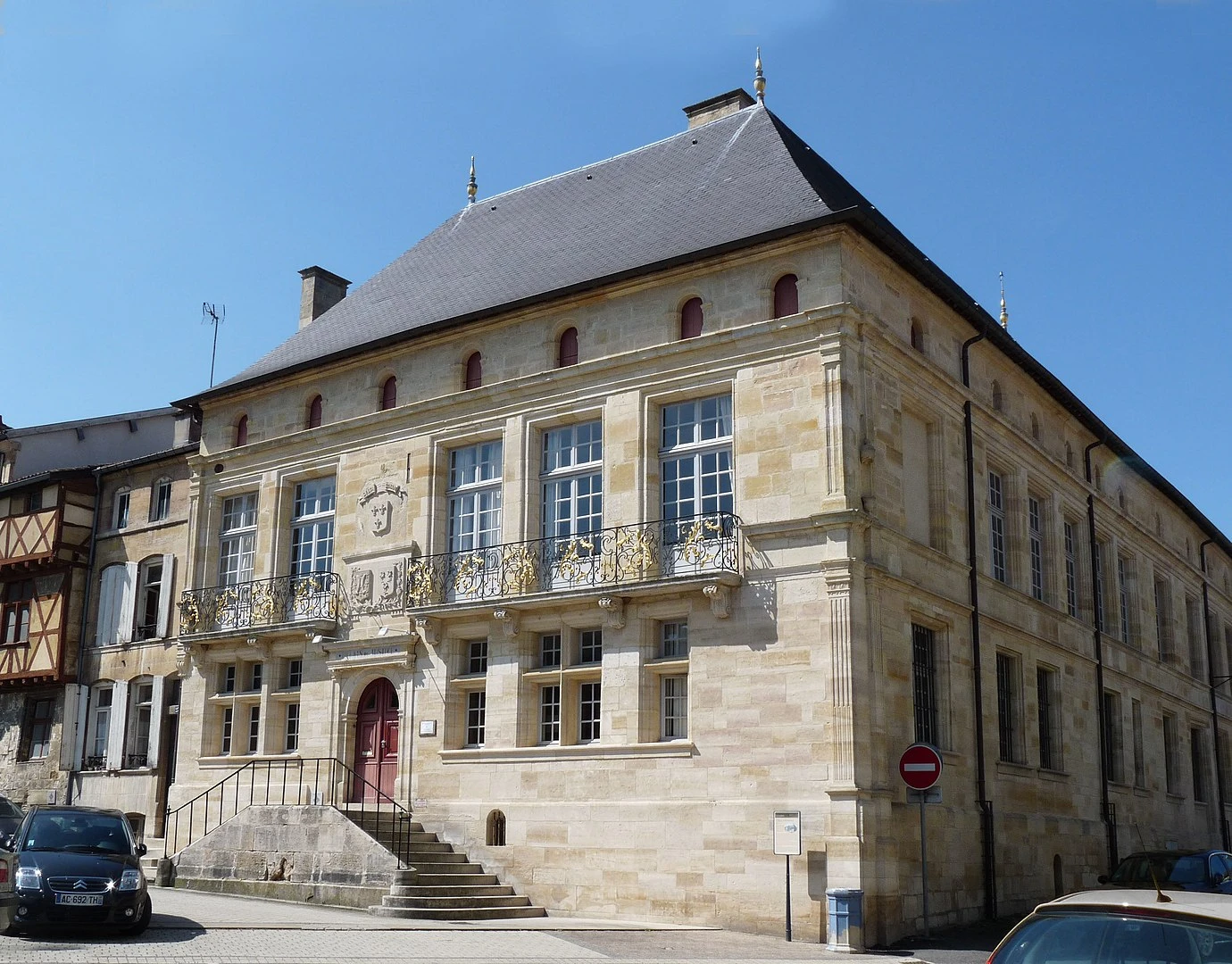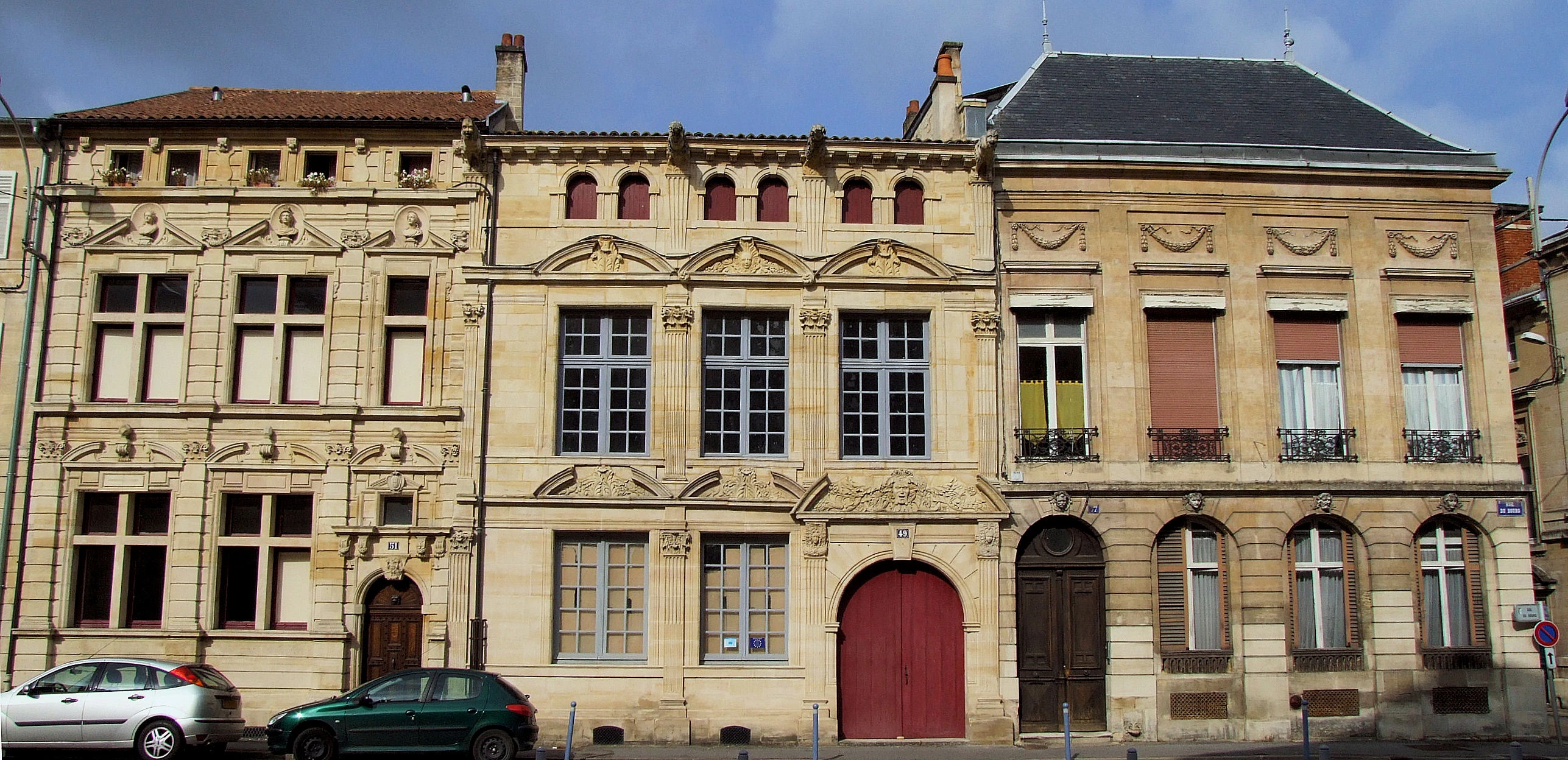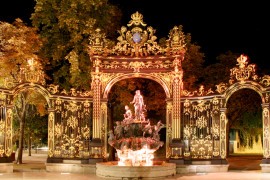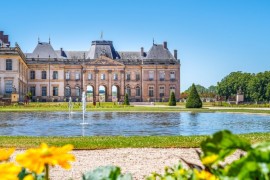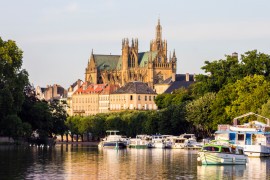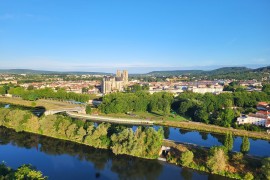Visit Nancy and discover its incredible heritage
L'arc Héré on the most beautiful square in the world in Nancy / Photo chosen by Monsieur de France: depositphotos.
Nancy UNESCO: Place Stanislas, the most beautiful square in the world
Wrought-iron railings are everywhere: they adorn entrances, fountains, they're also on the facade lampposts imagined by architect Emmanuel Héré. They were made by locksmith/ironmonger Jean Lamour in 1755. photo chosen by monsieur de France: shutterstock.com
1. What we see
Listed as a UNESCO World Heritage site since 1983, the 18th-century urban ensemble of Nancy is a jewel of urban planning and sculpture. It brings together three emblematic squares: the place Stanislas, the place de la Carrière and the place d'Alliance. Place Stanislas, often considered the most beautiful square in the world, impresses with its perfect proportions and elegant facades. Jean Lamour's gilded grilles add a superb touch of folly, as do the streetlamps. Guibal's baroque fountains and Stanislas Leszczynski's statue are the symbols of this decor. The Héré arch, crowned with a gold-leafed victory, links the Place Stanislas to the tree-lined, long Place de la Carrière, leading to the elegant Palais du Gouvernement. The more intimate Place d'Alliance has a charming listed fountain commemorating the 1756 treaty. Together, these three squares form a unique ensemble in Europe, testimony to the Enlightenment and its vision of the ideal city.
Detail of one of the fountains on Place Stanislas / Image by Agnès de Pixabay
2. What you can do
The place Stanislas is the heart of life in Nancy: you walk around, admire the facades, visit the Hôtel de Ville, the musée des Beaux-Arts and the Opéra national de Lorraine. It's also very French, with its typical cafés where you can settle down for a drink and a look. In summer, the "Rendez-vous place Stanislas" show illuminates the facades with spectacular animations. In autumn, an ephemeral garden gives it a whole new look. In winter, another show tells the legend of Saint Nicolas, patron saint of the people of Lorraine. The place de la Carrière offers a peaceful and majestic stroll, out of time, while the place d'Alliance invites you to a more confidential break. This ensemble is a must-see on any trip to Lorraine, to be discovered day and night. Nearby: Nancy's old town with its boutiques and cafés, the Palace of the Dukes of Lorraine and the Parc de la Pépinière, Nancy's central park with over 20 hectares of greenery including remarkable trees and Rodin's only outdoor statue.
The Government Palace on Quarry Square / Photo chosen by monsieur de France: depositphotos
📍 Distances: Place Stanislas in the center of Nancy (0 km) - 60 km from Metz
Nancy Art Nouveau: École de Nancy and Villa Majorelle
An art nouveau facade in downtown Nancy / Photo chosen by Monsieur de France; depositphotos.
1. What we see
At the end of the 19th century, Nancy became the French capital of Art nouveau with the École de Nancy. This movement, driven by artists such as Émile Gallé, Louis Majorelle, Antonin Daum and Jacques Grüber, drew inspiration from the forms of nature. The Villa Majorelle, built in 1901 by Henri Sauvage for Louis Majorelle, is a masterpiece of this style: undulating facade, colorful stained-glass windows, ironwork and integrated furniture. Recently restored, it allows visitors to admire the refinement of the period interiors. The musée de l'École de Nancy, housed in a bourgeois villa surrounded by a garden, exhibits glassware, furniture and decorative objects, all witnesses to the creative explosion of Art Nouveau.
The facade of the Villa Majorelle in Nancy / Photo chosen by Monsieurdefrance.com : Patrice Soudier de Pixabay
2. What you can do
The Villa Majorelle can be visited and immerses visitors in the refined world of the early 20th century. Each room illustrates the coherence between architecture, decoration and furniture. The musée de l'École de Nancy completes this discovery with an exceptional collection of glassware and furniture signed by the greatest designers. A stroll through the city also allows you to admire the Art Nouveau facades of the Saurupt district and Rue Félix Faure. The city center, too, is studded with typical buildings: from the Excelsior to the Chamber of Commerce, via rue Saint Jean and its boutiques. Nancy is today one of the few French cities where Art Nouveau is still so present in the urban fabric.
Detail of the art nouveau-style wrought-iron handle on the door of the Meurthe et Moselle Chamber of Commerce and Industry in Nancy. Photo chosen by monsieur de France: depositphotos
📍 Distances: Villa Majorelle at 1.5 km from Nancy center - 62 km from Metz
Metz and the cultural Moselle
Metz's Temple neuf seen from the rear, it overlooks Metz's Place de la Comédie. Photo chosen by monsieurdefrance.Com: Shutterstock.com
Metz: Saint-Étienne Cathedral and its stained-glass windows by Chagall
Metz Cathedral is made of Jaumont stone. Photo chosen by monsieurdefrance.com : Lev Levin / Shutterstock.
1. What we see
The cathédrale Saint-Étienne de Metz, nicknamed the "lanterne du Bon Dieu", is one of Europe's largest Gothic cathedrals, with nearly 6,500 m² of stained glass. Its Jaumont yellow stone gives it a brilliant golden color. Inside, you'll discover a soaring nave and stained glass windows spanning several centuries of history, from the Middle Ages to the 20th century. Among the most famous are the stained-glass windows by Marc Chagall, which bring a contemporary, poetic touch to this medieval gem. The exterior impresses with its sculpted facade and huge Gothic portal.
If Metz Cathedral is nicknamed "God's lantern" it's because it's the richest in stained glass in France and even Europe. Some are by Chagall. Photo chosen by monsieurdefrance.com : Lev Levin / Shutterstock.
2. What you can do
Visiting the cathedral helps you understand Metz's spiritual and artistic importance. You can admire the nave, the Gothic pulpit and Chagall's stained-glass windows. Outside, the place d'Armes offers an ideal vantage point over the whole, dominated by the cathedral spire. Guided tours reveal the history and secrets of this monument. At night, illuminations highlight the details of the façade. Lose yourself in the little streets all around to discover the magnificent details of the townhouses, to taste what one of the many restaurants in the area has to offer, or simply to take a seat on the Place Saint Louis. In the immediate vicinity of the Cathedral, the Tourist Office offers tours of Metz's historic center;
📍 Distances: Cathedral in the center of Metz (0 km) - 56 km from Nancy
Metz's Saint Etienne Cathedral seen by Night. Photo chosen by monsieurdefrance.com: Shutterstock.com
Center Pompidou-Metz: contemporary architecture
The Centre Pompidou Metz at dusk. Photo chosen by Monsieurdefrance.com: Shutterstock.com
1. What we see
Inaugurated in 2010, the Centre Pompidou-Metz is a masterpiece of contemporary architecture. Its spectacular wooden lattice roof, inspired by a Chinese hat, is a technical feat that seems to float above the galleries. The entire building is designed to host large-scale exhibitions of modern and contemporary art. Inside, three main galleries offer a varied scenography, often linked to the Centre Pompidou de Paris collection. Large picture windows offer unparalleled views of Metz, including the Imperial Station and the Amphitheatre district.
Detail of the wooden architecture of the Centre Pompidou Metz / Photo chosen by monsieur de France: depositphotos
2. What you can do
We visit the Centre Pompidou-Metz for its temporary exhibitions devoted to modern art, photography and contemporary creation. It also hosts conferences, screenings and workshops. Its large esplanade is perfect for admiring the building from different angles, especially at dusk, when the architectural lighting highlights its structure. It's a must-see for all lovers of art and architecture. Moving on, you'll discover the astonishing Imperial Quarter, built when Metz was annexed by Germany, and of which the railway station is the most astonishing monument.
📍 Distances: Centre Pompidou in the heart of Metz (1 km from the cathedral) - 57 km from Nancy
Located not far from the Centre Pompidou Metz, Metz station is France's most beautiful train station / Photo chosen by Monsieur de France: shutterstock.
Sainte-Croix animal park in Moselle
You can see wolves at the Parc animalier de Sainte Croix/ Photo chosen by Monsieur de France: by Christel SAGNIEZ de Pixabay
1. What we see
Located in Rhodes, Moselle, the parc animalier de Sainte-Croix is one of France's largest wildlife parks dedicated to European fauna. Covering more than 120 hectares, it is home to 1,500 animals belonging to around a hundred different species. Grey wolves, brown bears, lynxes, European bison, deer and fallow deer roam the vast semi-natural landscape. The park is also renowned for its conservation work and environmental education. The landscapes alternate between meadows, forests and lakes, providing an ideal setting for observing animals in an environment close to their natural habitat.
A lynx. They can be seen at Parc Sainte Croix / Photo chosen by monsieurdefrance.com : by Angela de Pixabay
2. What you can do
Visitors can follow various trails to observe the animals, take part in educational activities and enjoy immersive areas such as the deer plain. The park also offers unusual accommodations, such as wolf and bear huts. Families appreciate the play areas and educational activities on offer for children. It's a perfect place to combine relaxation, discovery and awareness of nature protection.
📍 Distances: Sainte-Croix at 74 km from Metz - 103 km from Nancy
The Maginot Line
The entrance to the Immerhof work one of the many Maginot Line works in Moselle / By Lvcvlvs - Own work, CC BY-SA 3.0, https://commons.wikimedia.org/w/index.php?curid=15544830
1. What we see
The Ligne Maginot is one of Europe's most famous military fortifications. Built between the wars to protect the French border from Germany, it stretched from Belgium to the Mediterranean. Among its structures, the fort du Hackenberg, located at Veckring in Moselle, is the largest and best preserved. It extends over 17 km of underground galleries and includes 19 combat blocks, casemates, artillery turrets and impressive technical systems. Designed to house 1,200 men, it was equipped with everything needed for a siege: power station, kitchens, infirmary and workshops. Today, it is the reference site for understanding the power of the Maginot Line. There are numerous forts throughout Moselle, Meurthe et Moselle (notably Fermont near Longwy) and Meuse. They are often maintained by enthusiasts;
2. What you can do
The Hackenberg guided tour immerses visitors in a true underground world. We travel through the galleries on a small electric train, discovering living rooms, ammunition stores and turrets still in working order. Some demonstrations show the period mechanisms in action, making the experience particularly lively. The site is also a place of remembrance: exhibitions recall the role of the Maginot Line during the Second World War and the lives of the soldiers who were assigned to it. Outside, trails provide a better understanding of the integration of these fortifications into the landscape. It's a unique visit, combining history, technology and memory.
📍 Distances : Nancy 100 km – Metz 30 km
The interior of the Hackenberg / Photo chosen by Monsieur de France: By Ungaroo - Udo Ungar - Own work, CC BY-SA 3.0, https://commons.wikimedia.org/w/index.php?curid=18596036
Meurthe-et-Moselle: history and heritage
Meurthe et Moselle is the department of which Nancy is the prefecture. Here a detail of one of the fountains on Place Stanislas / Photo chosen by Monsieur de France: depositphotos
The Château de Lunéville, Lorraine's Versailles
Le château de Lunéville seen from the gardens in bloom / Photo chosen by Monsieurdefrance.com: Shutterstock. com
1. What we see
The Château de Lunéville, nicknamed the "Versailles of Lorraine", was the residence of the dukes of Lorraine in the 18th century. Built for Leopold I and enlarged by Stanislas Leszczynski, it impresses with its classical architecture, majestic facades and formal gardens inspired by Le Nôtre. There are vast ceremonial salons, a royal chapel and superb landscape perspectives. Even partially rebuilt after a fire in 2003, the château retains all its splendor and remains a highlight of Lorraine's heritage.
Le château de Lunéville at sunset / Photo chosen by Monsieur de France: depositphotos.
2. What you can do
You can visit the ducal apartments, the chapel and the temporary exhibitions that enliven the site. The gardens, open to the public, are perfect for a romantic stroll along the ponds and flowerbeds. Throughout the year, the château hosts shows and concerts. It's a must-see if you want to understand the history of the Dukes of Lorraine and Lunéville's place in the political and cultural life of the 18th century, but it would be a shame to reduce Lunéville to the château alone. The town is very beautiful, in 18th-century style, and it boasts many astonishing placessuch as the Church of Saint Jacques and its hidden organ, the Hôtel Abbatial, which recreates the interior of a French aristocrat of the Age of Enlightenment, or the Maison du marchand.A few kilometers away are the Baccarat factoriesand the world's most famous crystal is made there.
📍 Distances : 33 km from Nancy - 88 km from Metz
The pink sandstone façade of the Maison du marchand in Lunéville& / photo chosen by Monsieurdefrance.com: Jérôme Prod'homme
Château d'Haroué, the home of princes;
Le château d'Haroué and its classic stone facade on the park side / Photo chosen by monsieur de France: shutterstock.
1. What we see
Built in the 18th century by architect Germain Boffrand for the Prince of Craon, the château d'Haroué is an example of French classical architecture. It impresses with its elegance and harmony: four bridges, twelve interior and exterior towers, 52 interior chimneys and 365 windows symbolize the year, months, weeks and days. The park, designed in both French and English styles, adds to the estate's charm. Inside, the salons are decorated with refined woodwork, tapestries and painted ceilings. This is the decor of a princely family, the first in the Duchy of Lorraine after that of the Dukes, and one of the most important at the French Court.
The Château de Haroué's gilded salon with its paintings and gold / Photo chosen by monsieur de France: Jérôme Prod'homme.
2. What you can do
You can visit the reception rooms, the private apartments and admire the richness of the decor, including the Chinese salon, the only one of its kind in the world. The château also hosts numerous cultural events: exhibitions, concerts and festivals that bring this heritage to life. The park lends itself to strolls, offering both geometric rigor and landscaped charm. Haroué is one of Lorraine's finest aristocratic residences, a true testament to 18th-century refinement.
📍 Distances : 27 km from Nancy - 82 km from Metz
Baccarat crystal chandelier visible at the Château de Haroué in the Louis XVIII salon / Photo chosen by Monsieur de France: Jérôme Prod'homme
The Sion-Vaudémont hill and its magnificent panorama
1. What we see
The colline de Sion-Vaudémont is one of Lorraine's most emblematic landmarks. At 540 meters above sea level, it dominates the surrounding landscape and offers an exceptional panorama over the plain and the Vosges mountains. It's a natural, historical and spiritual site in equal measure. At the summit is the basilique Notre-Dame de Sion, a Marian pilgrimage site since the Middle Ages, as well as archaeological remains reminiscent of the ancient Gallic oppidum. The hillside is surrounded by vineyards and orchards, highlighting its beauty.
La colline de Sion vue d'en bas / photo chosen by monsieur de France: By Carl-9000 - Personal work, Public domain, https://commons.wikimedia.org/w/index.php?curid=3325341
2. What you can do
You can visit the basilica, discover the history of the site in the musée de la colline and enjoy the hiking trails that criss-cross the hillsides. It's an ideal place to admire the sunset over the Lorraine plain. Every year, pilgrimages attract the faithful, but the site also appeals to nature and photography enthusiasts. Sion Hill embodies both the spiritual and landscape identity of Lorraine.
📍 Distances : 30 km from Nancy - 80 km from Metz
Lac de Pierre-Percée, Canada in Lorraine
Le lac de pierre-percée seen from the sky / Photo chosen by Monsieur de France: By Gzen92 - Own work, CC BY-SA 4.0, https://commons.wikimedia.org/w/index.php?curid=70420740
1. What we see
The lac de Pierre-Percée, in Meurthe-et-Moselle, is one of the largest man-made lakes in the Grand Est region, with a surface area of over 300 hectares and more than 30 kms of shoreline Its maple leaf shape and the colors that nature takes on in autumn, have earned it the nickname "Petit Canada lorrain". Surrounded by deep forests, fir trees and craggy reliefs,it offers landscapes of great wild beauty, reminiscent of the great Canadian open spaces. The lake is punctuated by small creeks, landscaped beaches and promontories that allow you to admire exceptional panoramas.
2. What you can do
It's an ideal place for outdoor activities: hiking around the lake, mountain biking, climbing and tree climbing. In summer, visitors can enjoy a leisure park. Autumn makes the place magical, with its red, gold and black colors. In winter, the site attracts photographers with morning mists and contrasting colors. Thrill-seekers can also try their hand at zip-lining or adventure courses. The lac de Pierre-Percée is a perfect destination to recharge your batteries in the middle of nature, halfway between leisure and contemplation. Not far away, you can enjoy the Fraisperthuis City amusement park with its thrills.
📍 Distances : 72 km from Nancy - 116 km from Metz
Autumn is always exceptional at Pierre-percée / Photo chosen by Monsieur de France: depositphotos.
The Basilica of Saint-Nicolas-de-Port, the spiritual heart of Lorraine
The imposing towers of the Basilica of Saint Nicolas de Port / Photo chosen by Monsieur de France: depositphoto.
1. What we see
The basilica of Saint-Nicolas-de-Port is one of the finest examples of Flamboyant Gothic in Lorraine. Built between 1481 and 1545 to house a relic of Saint Nicolas, the patron saint of the Lorraine people, it dominates the small town of Saint-Nicolas-de-Port. Its slender facade, framed by two tall towers, impresses as soon as you arrive. The interior surprises with its monumental proportions: a 30-meter-high nave, supported by slender pillars, bathed in light thanks to large colored stained-glass windows. There are also sculpted 16th-century stalls, frescoes and an imposing organ, one of the finest in the region. For centuries, this sanctuary has attracted pilgrims and visitors alike, and remains a strong symbol of Lorraine's identity.
The basilica of Saint Nicolas de Port as seen on arrival in the city / Photo chosen by Monsieur de France : By Antoine Taveneaux - Own work, CC BY-SA 3.0, https://commons.wikimedia.org/w/index.php?curid=4237272
2. What you can do
The tour allows you to discover the basilica's architecture, stained glass windows and monumental organ. Guided tours are regularly organized to better understand its history and treasures. Every year, on December 6, the town lives to the rhythm of the fête de saint Nicolas, with processions, illuminations and entertainment that attract thousands of people from all over Lorraine. The rest of the year, concerts and exhibitions enliven the sanctuary. Nearby shopping streets round off the visit. The brewery museum, housed in a magnificent art deco building, is also worth a visit. A spiritual and cultural Mecca, the Basilica of Saint-Nicolas-de-Port is a must-see for those who want to capture the soul of Lorraine.
📍 Distances : From Nancy : 13 km - From Metz : 63 km
In the Basilica of Saint Nicolas de Port, in Lorraine, Saint Nicolas recognizable by his bishop's habit and the three little children accompanying him. Photo chosen by Monsieurdefrance.com: Jérôme Prod'homme (c)
Toul: the cathedral and ramparts
Toul cathedral seen from the sky in the heart of the city and surrounded by ramparts and a loop of the Moselle River. Photo chosen by Monsieurdefrance.com: Jérôme Prod'homme.
1. What we see
The city of Toul, a former episcopal city, preserves a rich medieval and religious heritage. Its cathédrale Saint-Étienne, built from the 13th to 16th centuries, is a masterpiece of the Lorraine flamboyant Gothic style. The facade, flanked by two monumental towers, is adorned with sculpted portals and rosettes. Inside, the slender nave impresses with its luminosity and stained glass windows, some of which date back to the Middle Ages. Also worth seeing is the famous cloister, one of the largest in France. Further afield, the collegiate church of Saint Gengoult is equally impressive. Toul is also surrounded by remparts created in the 17th century by Vauban, and improved by Seré de Rivière in the 19th century, which give the town center a lot of allure and bear witness to the town's military past. The historic center, with its mansions and town houses, ancient alleyways and small squares, completes this exceptional heritage setting.
The beautiful facade of Toul's Saint Etienne Cathedral. Photo chosen by monsieurdefrance.com: jérôme Prod'homme (c)
2. What you can do
The cathédrale Saint-Étienne can be visited freely, and guided tours offer the chance to delve deeper into its history and architecture. The town center is rich in shops... The Musée d'Art et d'Histoire, housed in the former episcopal palace, presents archaeological and artistic collections. The port district is particularly popular in summer. Toul is also famous for its vignoble des Côtes-de-Toul, which produces the famous vin gris: a tasting at a local estate perfectly completes the visit. With its religious, military and wine-growing heritage, Toul is a must-see stop-off for understanding Lorraine's rich historical and culinary heritage.
📍 Distances : From Nancy : 25 km - From Metz : 75 km
La Cathédrale Saint Etienne de Toul: Photo chosen by monsieurdefrance.com: shutterstock.com
Vosges: nature, well-being and gourmet delights
The Vosges is a land of nature and fresh air / Photo chosen by Monsieur de France: depositphotos.
Lake Gérardmer, the pearl of the Vosges
The view from one of the pontoons on Lake Gérardmer / photo chosen by Monsieurdefrance.com : Jean Martinelle de Pixabay
1. What we see
The lac de Gérardmer, the largest natural lake in the Vosges (115 ha), is nicknamed the "perle des Vosges". Nestled at an altitude of 660 m, it is bordered by fir forests and surrounded by green hills. Its glacial origin gives it an elongated shape and crystal-clear waters. Its beauty attracts all seasons: in summer with its beaches, in autumn with its flamboyant colors, and in winter when snow covers the shores. The panorama from the heights, particularly from the Mérelle tower, is spectacular.
2. What you can do
The lake offers a multitude of activities: supervised swimming in summer, pedal-boating, kayaking or sailing, and hiking on the 6 km trail that circles the lake. In winter, Gérardmer also becomes a renowned ski resort. Events like the Fête des Jonquilles or the Festival du Film Fantastique complete the town's appeal. Gérardmer lake is therefore a natural site, a leisure spot and a tourist symbol of the Vosges.
📍 Distances : From Nancy : 111 km - From Metz : 150 km
Lac de Gérardmer seen from the sky / Photo chosen by Monsieur de France: depositphotos.
Tendon's great cascade
1. What we see
The cascade de Tendon, located between Gérardmer and Épinal, is the highest waterfall in the Vosges, with a 32-metre drop. In the middle of a forest, the water cascades down a rocky escarpment in a wild, verdant setting. A few minutes' walk away is the petite cascade, more discreet but just as charming. The whole ensemble forms a spectacular natural site, appreciated for its freshness and beauty in all seasons.
La grande cascade de Tendon / Photo chosen by Monsieur de France: Imladris via depositphotos
2. What you can do
A marked trailprovides easy access to the large cascade, making it an ideal walk for families. Hikers extend the visit to the small cascade. It's also a perfect spot for nature photographers: autumn colors the foliage, and winter sometimes offers striking ice sculptures. On-site picnic areas complete the charm of the visit.
📍 Distances : Nancy 110 km – Metz 150 km
La Schlucht and La Bresse, the heart of the Vosges mountains
Hiking in the snow in winter at La Bresse and in the Hautes-Vosges, a real pleasure! Photo chosen by Monsieurdefrance.com: by Trevor M from Pixabay
1. What we see
The col de la Schlucht, at an altitude of 1,139 metres, is one of the most famous in the Vosges. It offers spectacular panoramic views of the Lacs valley, the blue line of the Vosges and, on a clear day, the Black Forest and the Alps. All around are landscapes of high stubble fields, deep forests and impressive cliffs. Just a few kilometers away, the resort of La Bresse-Hohneck, the largest ski resort in northeastern France, attracts visitors in all seasons.
The landscape is often snow-covered in winter, even if there's no snow a little lower down / Photo chosen by Monsieur de France: by leon grandjean de Pixabay
2. What you can do
In winter, La Bresse offers over 30 downhill ski runs, cross-country skiing and snowshoeing itineraries. In summer, hiking trails, such as the sentier des roches, appeal to walkers. The Col de la Schlucht is also a passageway for the GR5, a mythical European trail. At La Bresse, nature lovers will also find a large mountain bike domain, a giant zip line and family activities. It's a mecca for mountain tourism in Lorraine.
📍 Distances : Nancy 115 km – Metz 155 km
If you love forests, nature and walking, you'll love the Vosges / Photo chosen by Monsieur de France: depositphotos
The High Vosges and the Route des Crêtes
The view from the Honneck is magnificent / Photo chosen by Monsieur de France: rimagebrokermicrosto via depositphotos
1. What we see
The Hautes Vosges form the backbone of the Vosges massif, with its emblematic peaks: the Hohneck (1,363 m), the Kastelberg or the Rainkopf. The route des Crêtes, built during the First World War, links Cernay to the Col du Bonhomme for almost 80 km. It offers spectacular views over the Alsace plain and Vosges valleys, punctuated by glacial lakes such as Lac Blanc and Lac des Truites. The landscape alternates between dark forests, high stubble fields and pastures.
La route des crêtes winding through the Vosges mountains / Photo chosen by Monsieur de France: depositphotos.
2. What you can do
The route can be explored by car, bike or motorcycle, with numerous scenic lookouts. Hikers will appreciate the signposted circuits leading to the Hohneck or the high-altitude lakes. You can also discover the fermes-auberges of the Vosges, which perpetuate the tradition of the marcaire meal: tourte, collet fumé, tofailles and munster fermier. It's an experience that's both scenic and gastronomic.
📍 Distances : Nancy 120 km – Metz 160 km
La roche du diable on the route des crêtes between Le Schlucht and Gérardmer / Photo chosen by Monsieur de France: despositphotos
Vittel and Contrexéville, spa towns
1. What we see
In the heart of the Vosges mountains, Vittel and Contrexéville are two internationally renowned spa resorts. Vittel, known since the 19th century, boasts a 650-hectare spa park, Belle Époque architecture and an elegant covered gallery. Contrexéville, more intimate, seduces with its casino, spa park and health establishments. Both towns owe their renown to the quality of their mineral waters, marketed worldwide.
Vittel is one of France's most renowned spa resorts / photo chosen by Monsieur de France: shutterstock.
2. What you can do
In Vittel, you can visit the parc thermal, the Palais des Congrès and the thermal baths, where cures and wellness treatments are offered. The town is also home to a golf course, a racecourse and sporting events. In Contrexéville, thermal baths specializing in slimming and well-being complete the offer. These resorts combine heritage, health and relaxation, making them the ideal duo for a relaxing getaway.
📍 Distances : Nancy 90 km – Metz 135 km
The Grand Hôtel de Vittel reflects the typical belle époque architecture that characterizes Vittel / Photo chosen by Monsieur de France: By Pymouss - Own work, CC BY-SA 4.0, https://commons.wikimedia.org/w/index.php?curid=36259602
La Confiserie des Hautes Vosges in Plainfaing
1. What we see
Based in Plainfaing, the Confiserie des Hautes Vosges is an artisanal company founded in 1986 and today a must. It perpetuates the tradition of bonbons vosgiens made with essential oils of fir, honey, eucalyptus or even pine buds. The candies are made in front of visitors, in copper cauldrons, using authentic recipes.
This is where genuine Vosges sweets are made / Photo chosen by Monsieur de France: CDHV website
2. What you can do
The guided tour of the confectionery is free and allows you to witness all stages of production. It ends with a tasting and a visit to the store, where you'll find a wide range of traditional sweets. The Confiserie des Hautes Vosges welcomes almost 250,000 visitors a year, making it one of Lorraine's most popular tourist sites. It's a gourmet and friendly stopover in the heart of the mountains.
📍 Distances : Nancy 95 km – Metz 140 km
This is where the real Vosges sweets are made/ Photo chosen by Monsieur de France: By Ji-Elle - Own work, CC BY-SA 4.0, https://commons.wikimedia.org/w/index.php?curid=50484004
Meuse: memory and Renaissance
Verdun and its memorial sites
The famous Douaumont ossuary, just outside Verdun, contains the remains of tens of thousands of bodies that have not been identified / Photo chosen by Monsieur de France: depositphotos
1. What we see
The town of Verdun is the symbol of the First World War. It was around it that, in 1916, one of the deadliest battles in history took place over 300 days and 300 nights, leaving over 300,000 dead and missing. Today, the memory of this conflict can be discovered through several major sites. The ossuaire de Douaumont, inaugurated in 1932, houses the remains of 130,000 unidentified French and German soldiers and overlooks a cemetery of 16,000 graves. Its lantern tower offers a striking view of the battlefield. The underground citadel, built by Vauban and then developed in 1914-1918, comprises 7 km of galleries where soldiers, health services and command lived. Finally, destroyed villages like Fleury-devant-Douaumont, never rebuilt, are a reminder of the extreme violence of the fighting.
The World Peace Center is a superb museum. The former palace of the bishops of Verdun is high up, and the view it affords of the city is magnificent / Photo chosen by Monsieur de France: By Fryderyk - Own work, CC BY-SA 3.0, https://commons.wikimedia.org/w/index.php?curid=11186461
2. What you can do
A visit to Verdun and the surrounding area is a plunge into history. At the Douaumont ossuary, a crypt and exhibition explain the context of the battle. The underground citadel can be visited by electric train, with an immersive presentation. Nearby, the forts of Douaumont and Vaux, and the Verdun Memorial, complete the discovery. For families and the curious, there are educational trails to help them understand the lives of the poilus. Verdun is both a place of universal remembrance and a space for reflection on peace. That saidwe shouldn't sum up Verdun with the memorial sites. It's a very pretty town, with narrow streets lined with houses with elaborate facades. There are many original monuments, and there's nothing more pleasant than a stroll or a drink along the Meuse on the Quai de Londres;
📍 Distances : Nancy 115 km – Metz 60 km
Verdun today is a very pleasant town on the banks of the Meuse River / Photo chosen by Monsieur de France: depositphotos
Bar-le-Duc, Renaissance town
The upper town of Bar le Duc / Photo chosen by Monsieur de France: By Moreauy1 - Own work, CC BY-SA 3.0, https://commons.wikimedia.org/w/index.php?curid=6945610
1. What we see
The town of Bar-le-Duc, prefecture of the Meuse department, is renowned for its Renaissance quarter: the ville haute. Dominated by the former château of the Dukes of Bar, it lines up magnificent 15th- and 16th-century townhouses, with sculpted facades and monumental staircases. Among the most remarkable are the Hôtel de Florainville, the Maison Colin and the Hôtel de la Monnaie. The Musée Barrois, housed in the former château, preserves collections of local art and history. The stone is blonde. The view is far-reaching. And even in the lower town you'll find all the ingredients of a typical French town, which should delight tourists who want to discover authentic France;
Typical of the upper town, with the blonde stone facade, the hôtel particuliere de Florainville / Photo chosen by monsieurdefrance.com : By Ji-Elle - Own work, CC BY-SA 3.0, https://commons.wikimedia.org/w/index.php?curid=15137450
2. What you can do
Other typical houses in Bar le Duc / Photo chosen by Monsieur de France: By MOSSOT - Own work, CC BY 3.0, https://commons.wikimedia.org/w/index.php?curid=15584509
A stroll through the ville haute allows you to admire the Renaissance facades and enjoy panoramic views over the Ornain valley. The Barrois museum sheds light on the history of the duchy and the town. In the lower town, the church of Saint-Étienne houses the famous transi by Ligier Richier, a strikingly realistic 16th-century funerary sculpture. Last but not least, Bar-le-Duc is also known for its gooseberry seeded quill jam, a unique specialty. It's a cultural and gourmet destination, ideal for a stopover in the Meuse. By car, it's not far to Saint Mihiel, which is well worth a detour, with its abbey, mansions and other works by Ligier Richier. Commercy is also very pretty, with its château, and very gourmet, with its madeleines, a recipe that originated in this town in the 18th century;
📍 Distances : Nancy 80 km – Metz 90 km

